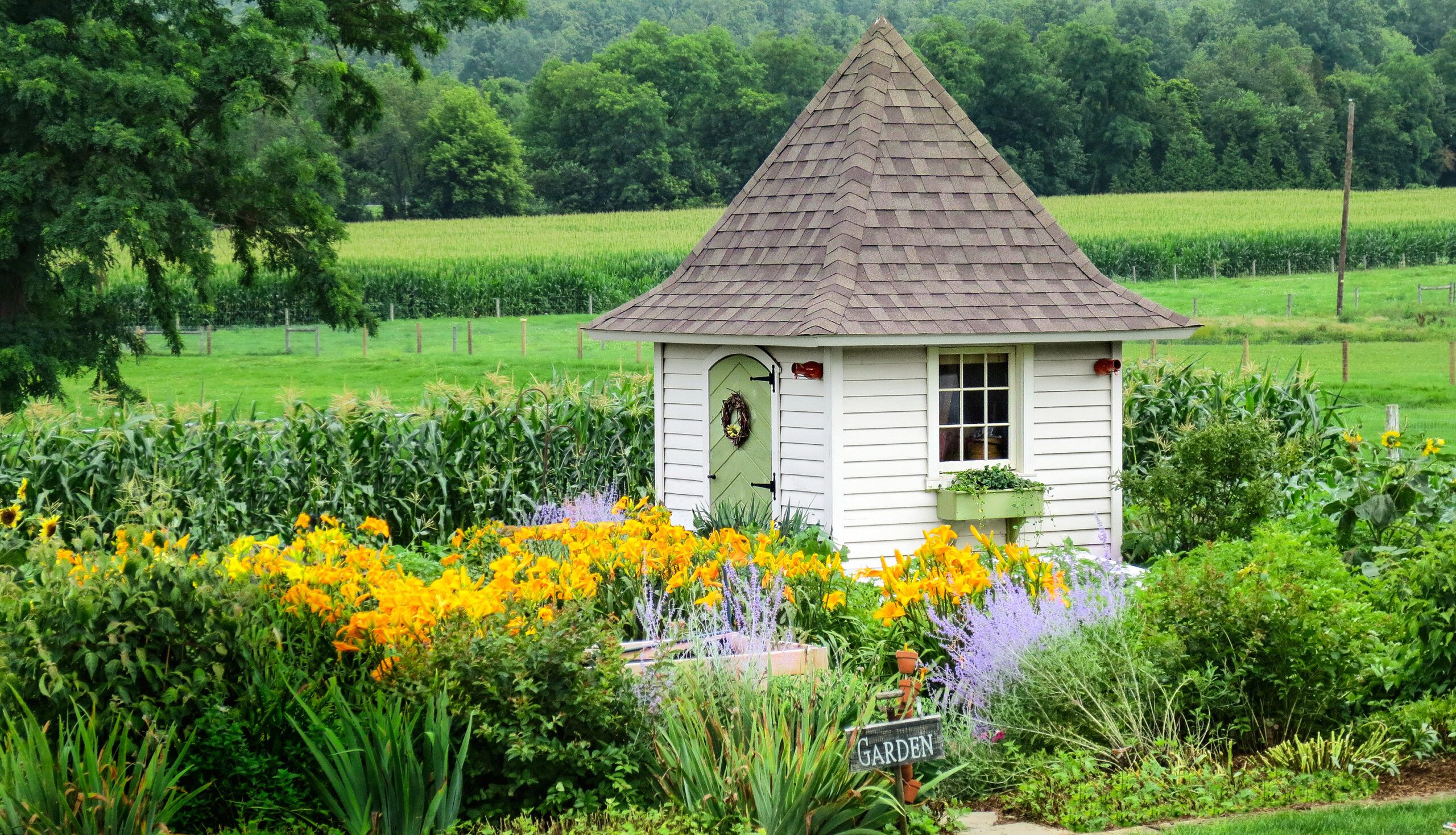As any gardener knows, it takes a host of specialized tools and gear—spades, trowels, shears, gloves, and the like—to do the cultivating, weeding, transplanting, and pruning that plants require. A garden shed offers a dedicated place to keep it all, plus lawn-care equipment and supplies, away from the unrelated clutter in most garages.
But a shed can be much more than a mere storage locker. It can serve as a focal point on your property, adding a defining element to your garden. It offers a pleasant space for puttering and potting, starting seeds, propagating cuttings, and dividing plants to share with friends. And it can be a snug, peaceful escape from the demands of a schedule-crammed life, and a place to commune with the outdoors.
In order to function at its full potential, no matter its size, a garden shed needs a few key features: at least one window—operable, ideally—to let in light and views and fresh air; enough floor space and headroom to allow you to stand up and walk around; and a worktable of some kind, for tinkering with plants or doing garden-tool maintenance.
Beyond providing for those basics, let your imagination be your guide. As you’ll see in the following pages, these houses-in-miniature inspire outsize creative expression. “Sheds are truly intimate spaces,” says designer Ken Smith, owner of Gardensheds.com. “That’s why we see people going to great lengths to personalize them, trick them out, and make them suit their individual needs.”
Read on for our guide to all things garden shed, from choosing the right size to picking the best place to put it.
Shown: Set amid a riot of summer blooms, this garden shed sports a pyramidal bonnet roof, a type of hip roof that changes pitch near the eaves.
8-by-8-foot prefab Zenith Garden Tower, from $7,000; Homestead Structures
Questions to Ask Before Investing
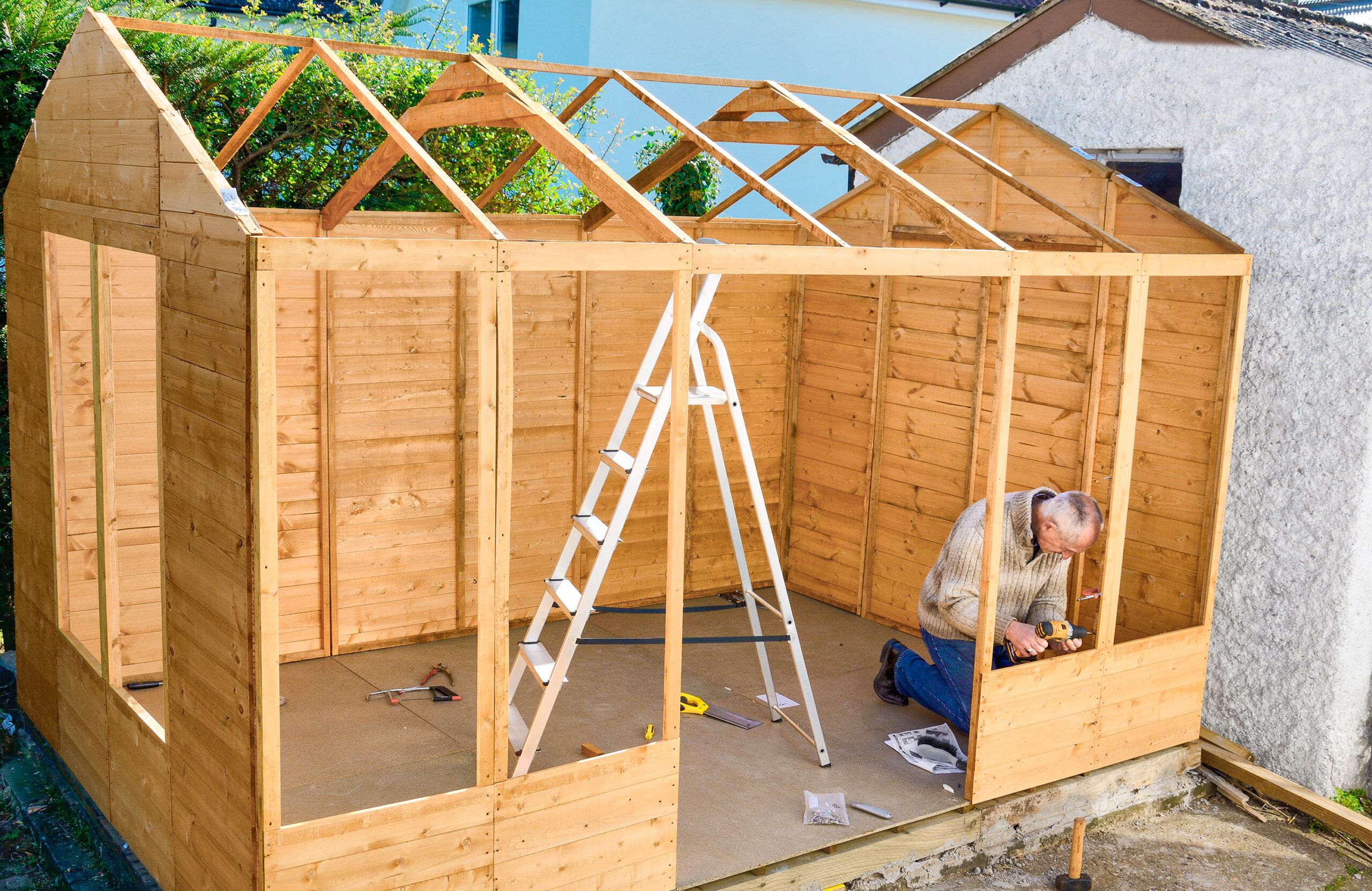
How Much Does It Cost?
Plastic resin sheds start at about $500 for a 4-by-7-footer. You can get a basic 8-by-10-foot, all-wood kit for around $1,800. Prices escalate rapidly from there with bigger sizes and added features. Custom-designed-and-built sheds run the gamut from $50 to $200 (and more) per square foot.
DIY or Hire a Pro?
Unless you have a prefab trucked in fully assembled, your shed will have to be built from a kit or from scratch. A seasoned DIYer could handle either, given enough time, though extra hands are a big help. A crew from a home center or manufacturer can erect a kit shed in a day or two. It’s your responsibility to prepare the shed’s base.
Where to Buy One?
Home centers and lumberyards sell kits in a range of styles, materials, and sizes. Or go online to explore a wider world of kit- and prefab-shed makers. Some ship anywhere; others deliver only within their region.
Are Permits Required?
Regulations vary; consult your town’s building and zoning departments before you buy. A small shed, around 100 square feet, may not need a building permit, but could require one for zoning.
Building a Garden Shed
What’s best depends on your available time, budget, patience—and level of building skill.
Kits
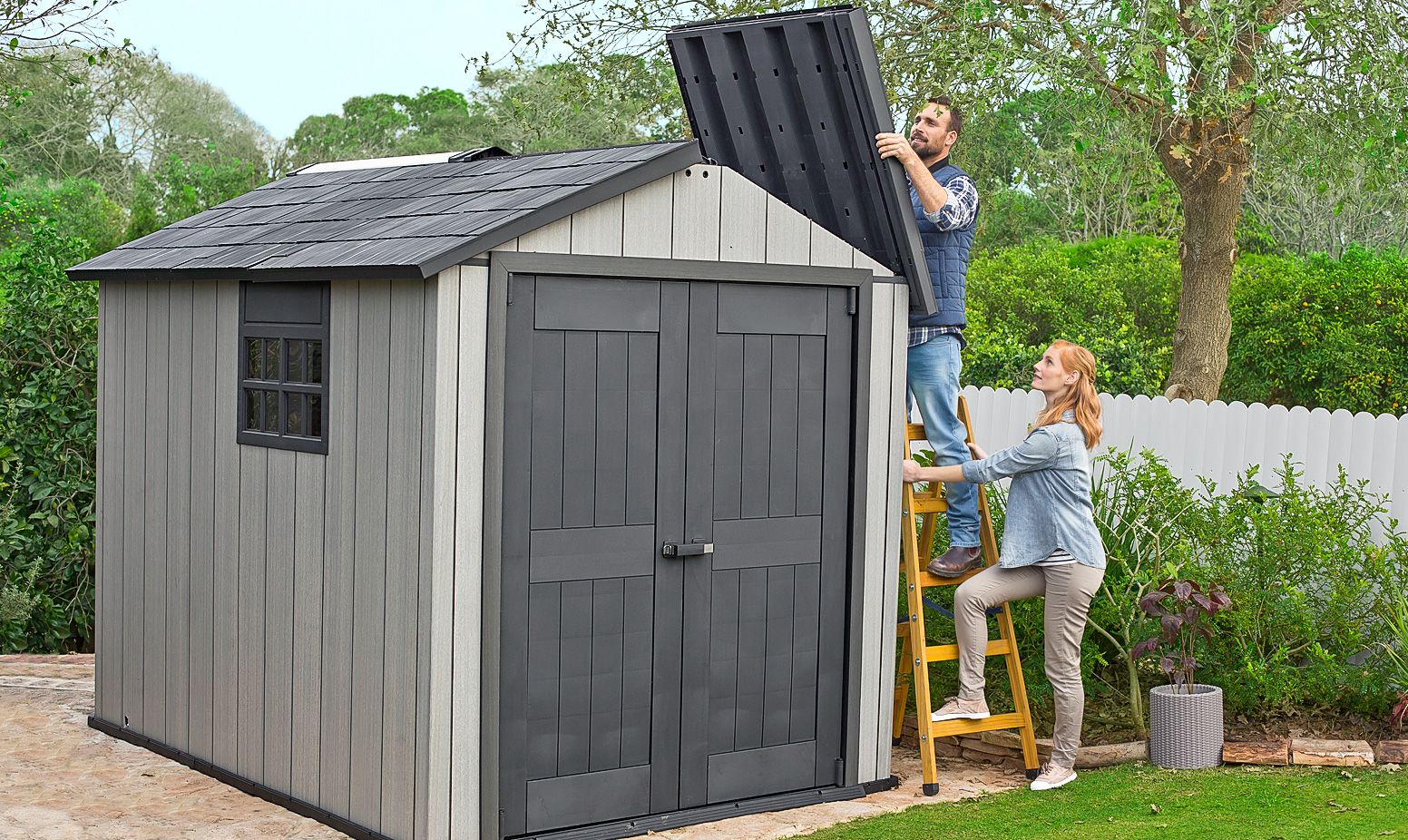
Parts are cut and partially assembled in a factory for easy delivery on a flatbed truck. Shed kits come in many sizes, styles, and materials, including wood, composite lumber, and steel-framed plastic (shown).
PROS: Kits speed assembly compared with building from scratch. Their purchase prices and transportation costs tend to be lower than those for prefab sheds of similar size.
CONS: Assembling a kit does take time, tools, and basic DIY know-how. If you’re lacking any of those, you’ll want to hire a crew from the manufacturer or home center supplying the kit to build it on-site, adding to the cost.
Kit shed: Oakland 759, Keter
Prefab
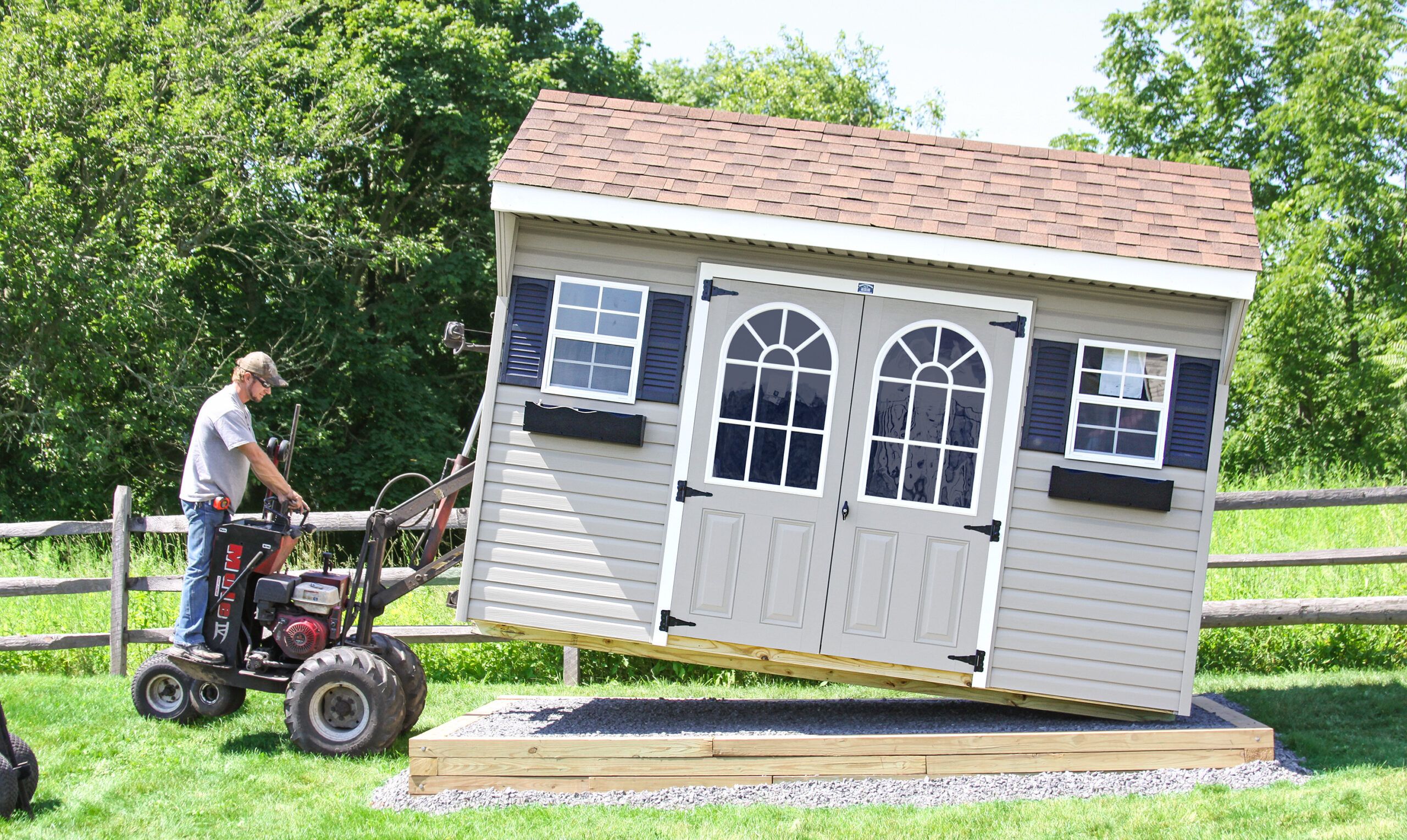
Sheds built in a factory benefit from a level of consistency and quality control that’s hard to achieve in the field. Just make sure there’s a clear path for a forklift to carry the shed from truck to base (as shown).
PROS: There’s next to no wait time. As soon as the shed is placed, you can start using it.
CONS: Fewer companies offer this option. Transportation costs can be substantial, depending on the size of the shed and how many miles it has to be trucked. A shed that’s more than 8½ feet wide will qualify as an oversize load. Anything wider than 12 feet may require escort vehicles.
Prefab shed: Classic Workshop Shed, Sheds Unlimited
DIY Plans
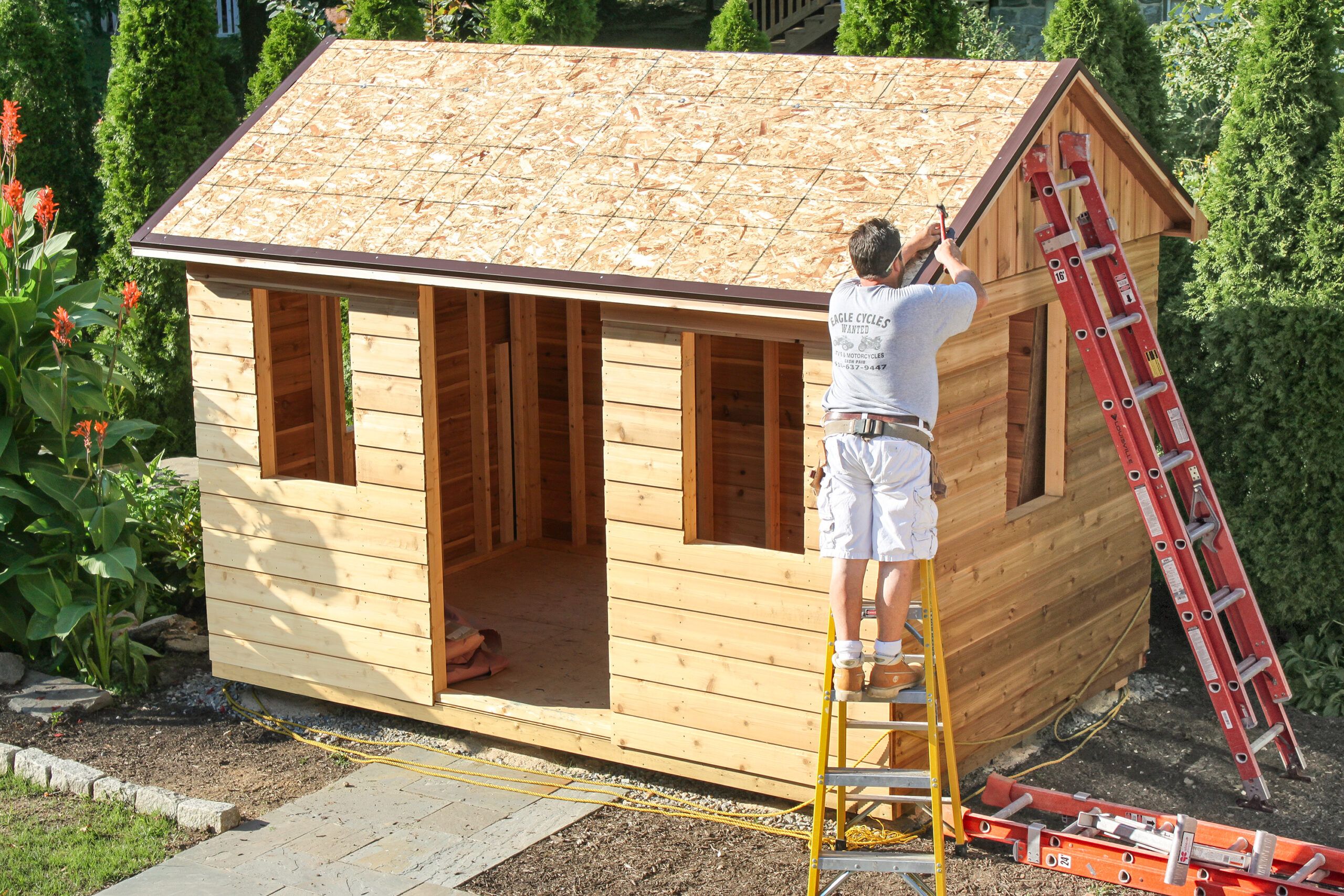
Building a shed from scratch (as shown) gives you control over the design, offering the chance to create a custom structure that stands out from the rest.
PROS: It feels good to say “I built that,” and doing the work yourself is a good way to save money and improve your skills. You can create a shed that echoes your house, and outfit the inside to your exact specs.
CONS: Without the requisite tools and acumen, it can be hard to get this DIY project off the ground—or finish it. The cost of a custom-designed, pro-built shed can easily soar past the price of a kit or prefab.
Size Matters
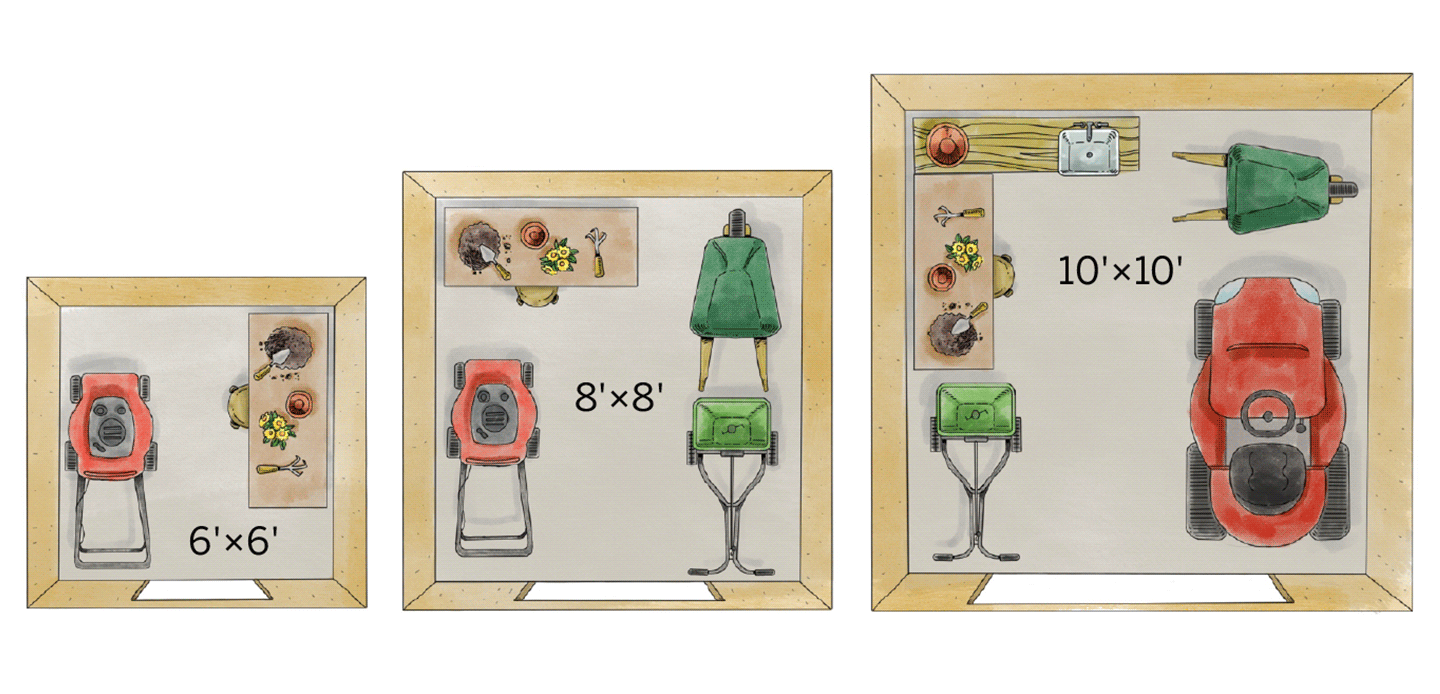
Sheds come in so many sizes, it can be hard to know which one will meet your needs. Use the tip and sketches to figure out which footprint will work best. Also factor in wall and roof heights: Six-foot walls are typical, but taller ones are also available. Having more headroom helps a small space feel less confining and adds to its storage capacity. Don’t dismiss sizes that seem bigger than necessary. Interiors have a way of shrinking as stuff accumulates.
Foundation Layout
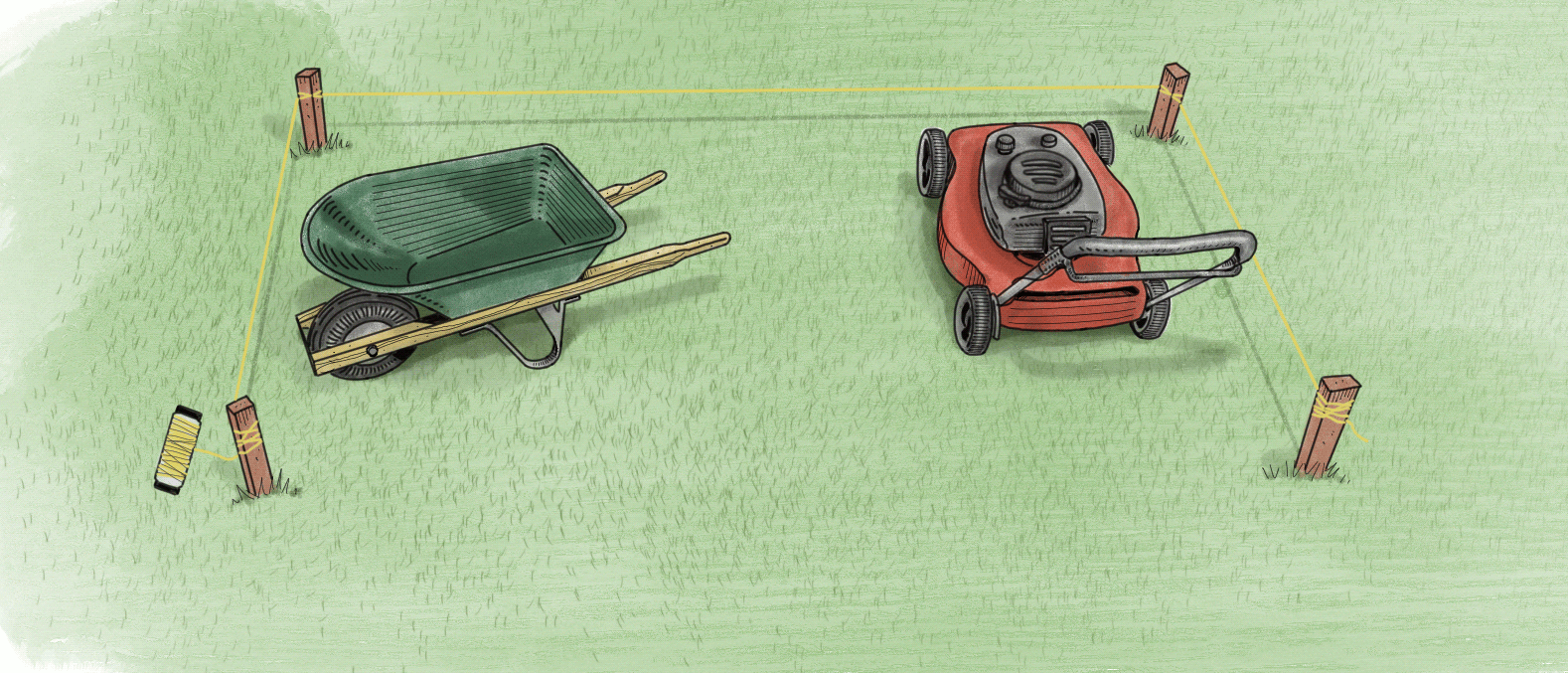
To see what will fit inside, lay out a footprint using four stakes and string a mason line between them. Adjust the stakes as needed to accommodate your items. Don’t forget to account for the door, and leave at least 24 to 36 inches in front of a potting bench and beside equipment for you to move around comfortably.
Roof Types
A shed’s roof shape defines its style—and interior volume.
Gable
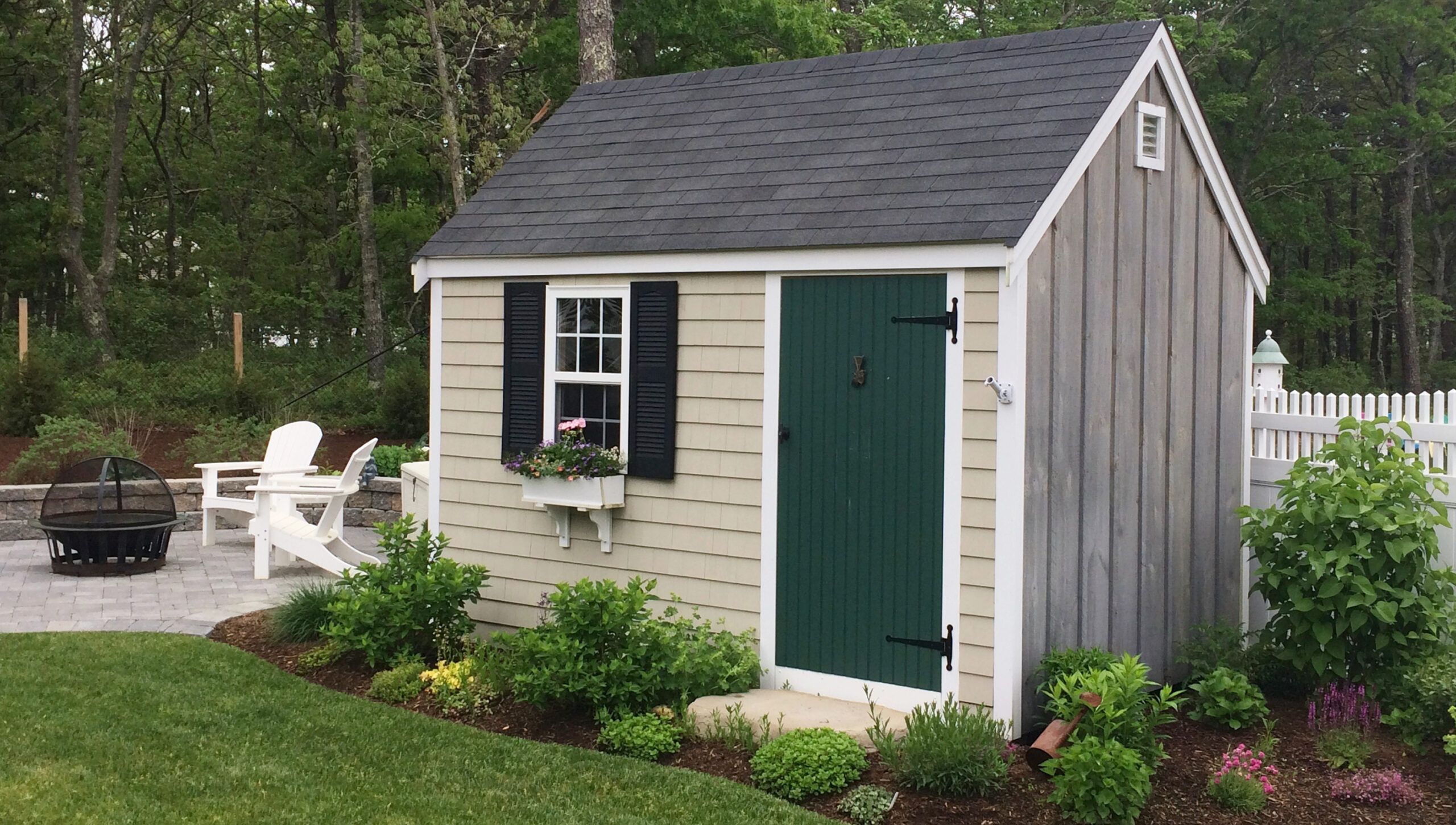
This simple, familiar style is formed by two equal roof planes sloping down on either side of a straight ridge. High-peaked roofs, like this one, offer more headroom and the possibility of extra overhead storage.
Shown: 8′ x 12′ Quivett Cape kit, starting at $3,700; Pine Harbor Wood Products
Catslide
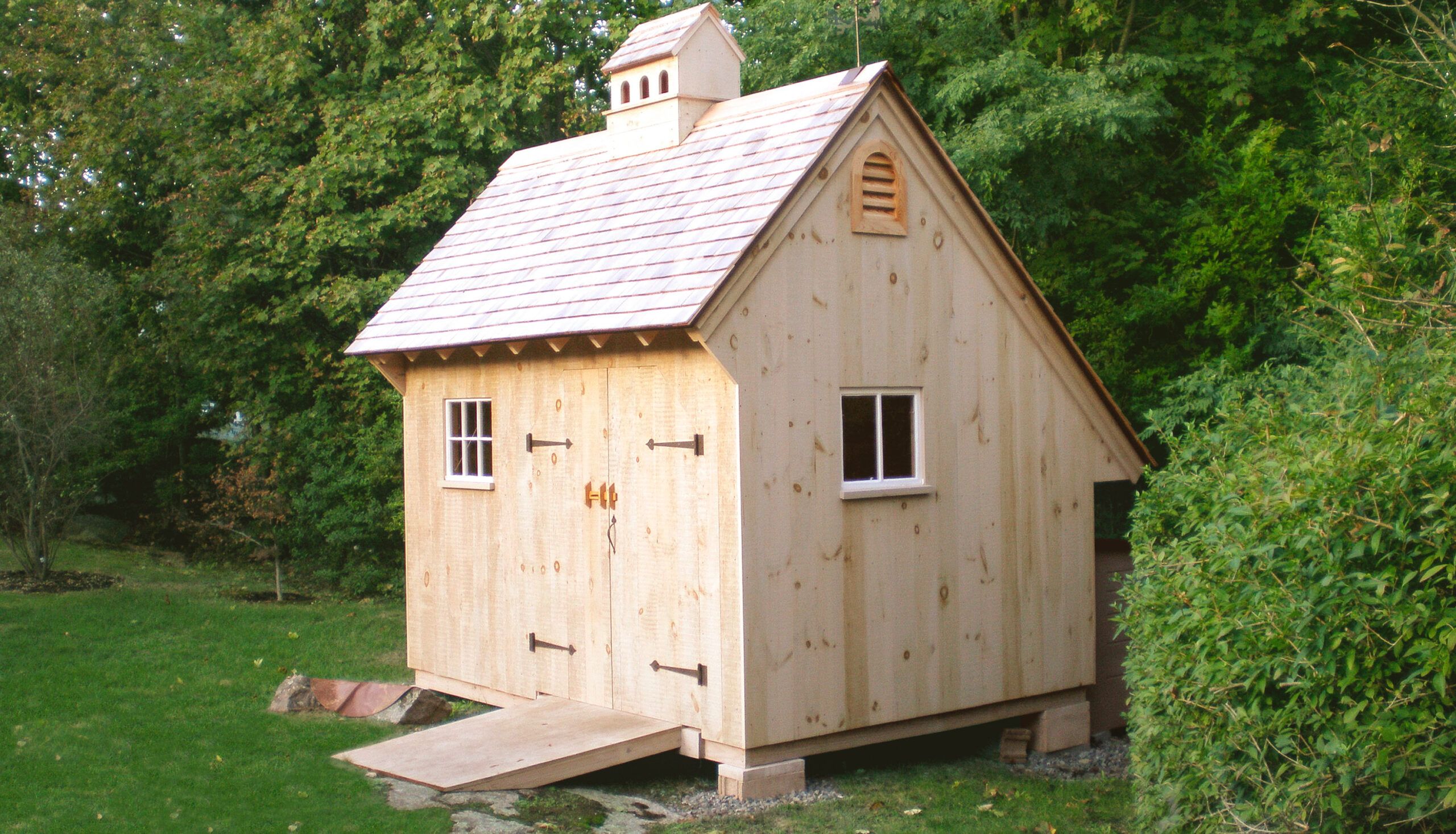
A defining feature of colonial-era saltboxes in New England, the back side of this roof slopes down to within a few feet of the ground. This design offers more floor space than a gable roof of the same height, but not the headroom to go with it.
Shown: 9′ x 12′ custom shed, about $6,000; Norm’s Homework Inc.
Shed Roof
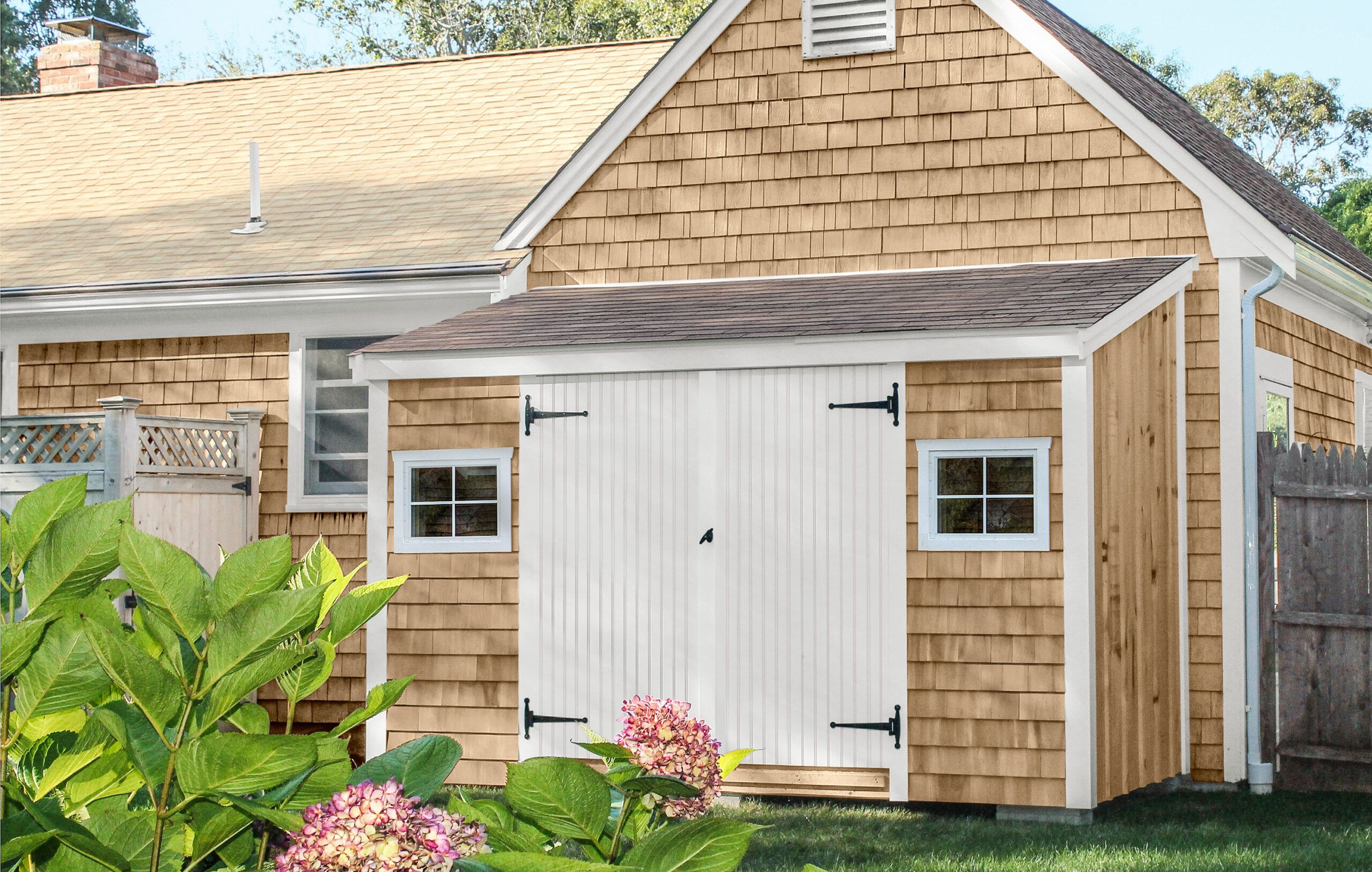
A single plane sloped toward the front leaves a high back side that begs to be nestled against a taller wall, forming a lean-to. This simplest of shed designs is well suited to storing lots of garden gear within a compact footprint.
Shown: 6′ x 12′ Cuttyhunk kit (no windows), $2,700; Walpole Outdoors
Gambrel
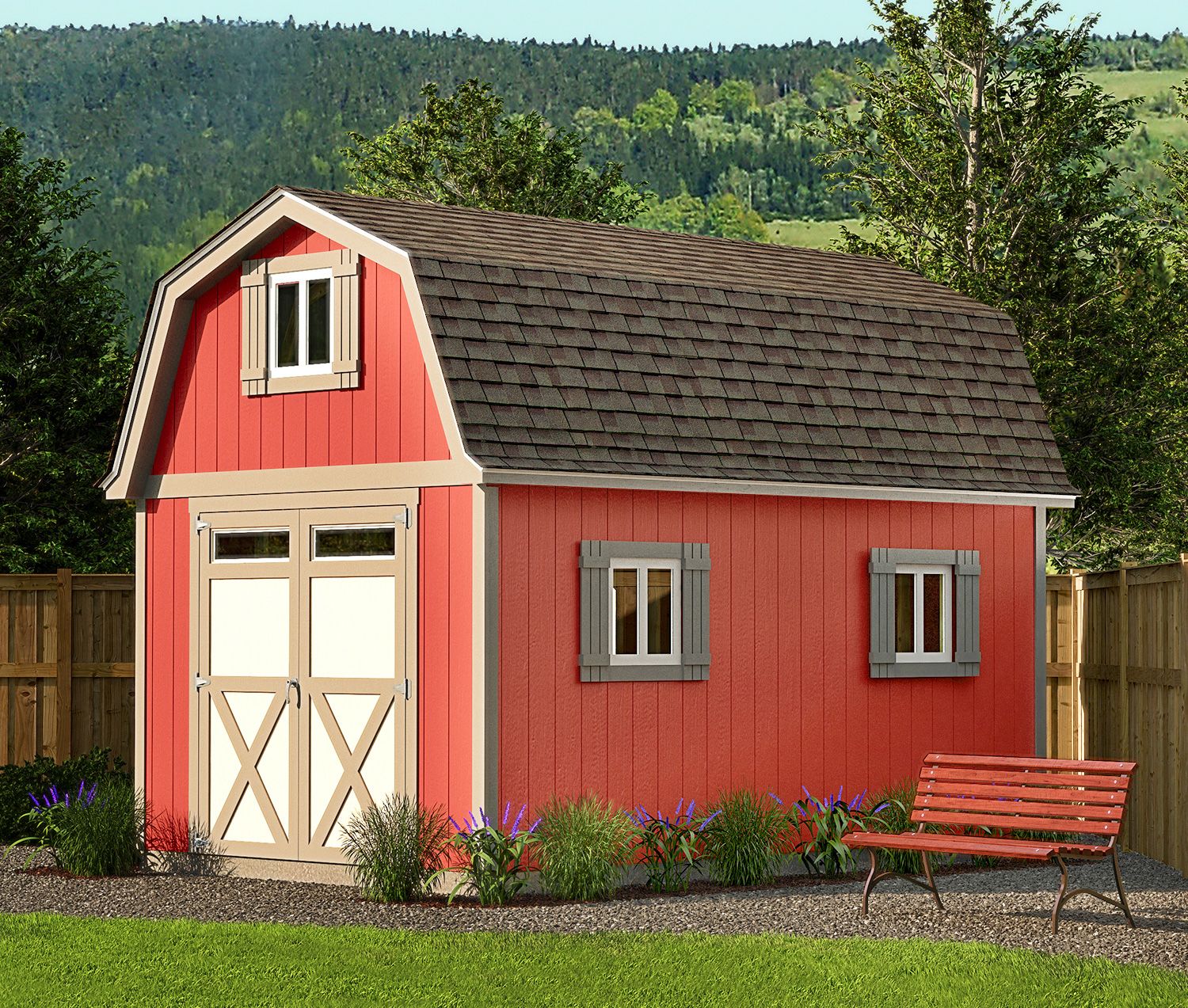
Hips on both sides of a gable roof form the classic barn-roof profile that adds lots of volume up top—often enough for a storage loft—without the need for a taller building.
Shown: 12′ x 16′ Pro Series Tall Barn kit, $6,166; Tuff Shed
Flat
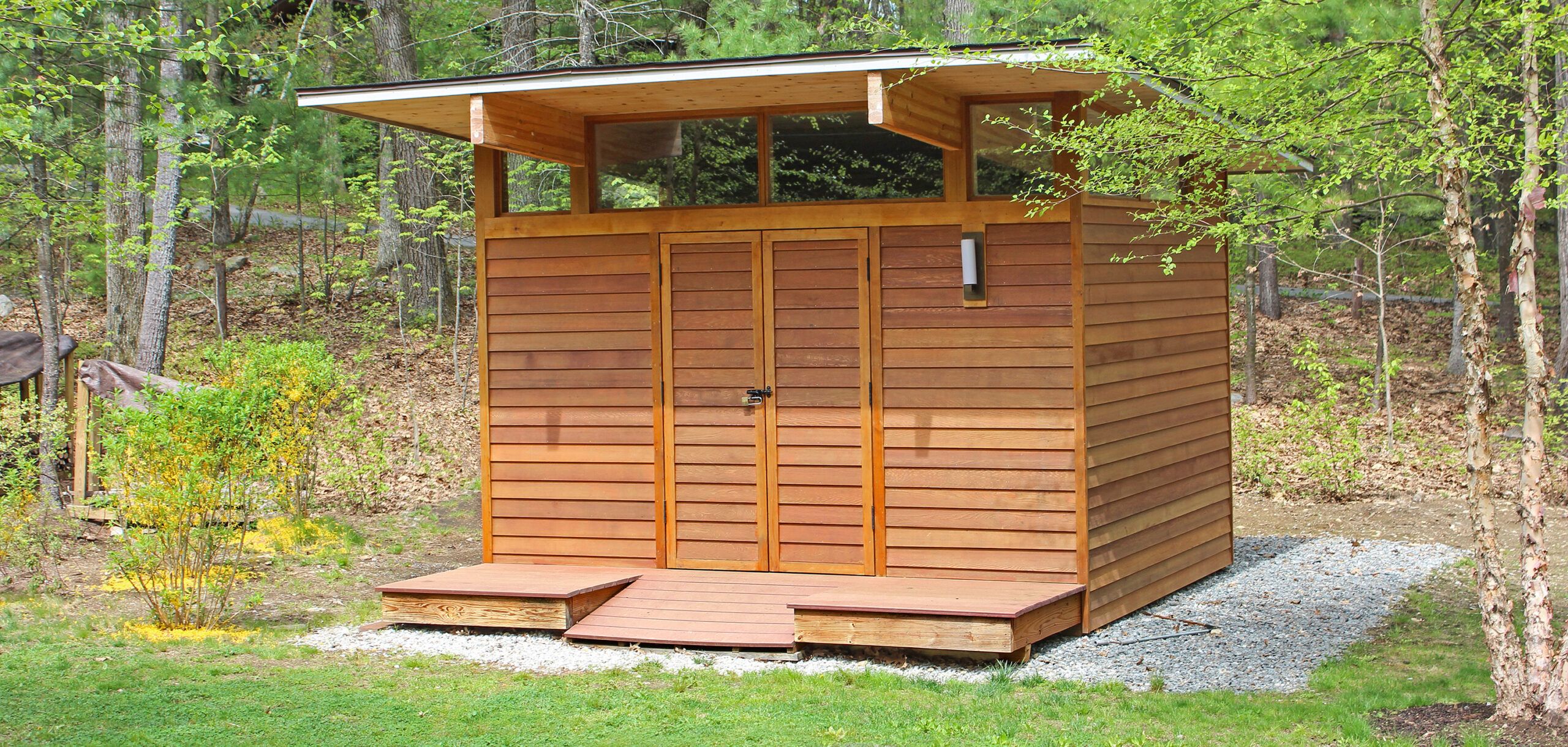
A roof with little or no pitch, set over four rectilinear walls, is the hallmark of a modern shed and a good way to maximize interior headroom. Here, the clerestory windows leave uninterrupted wall space inside for workbenches and storage.
Shown: 10′ x 12′ custom design, about $25,000; Buchanan Custom Builders
Hip
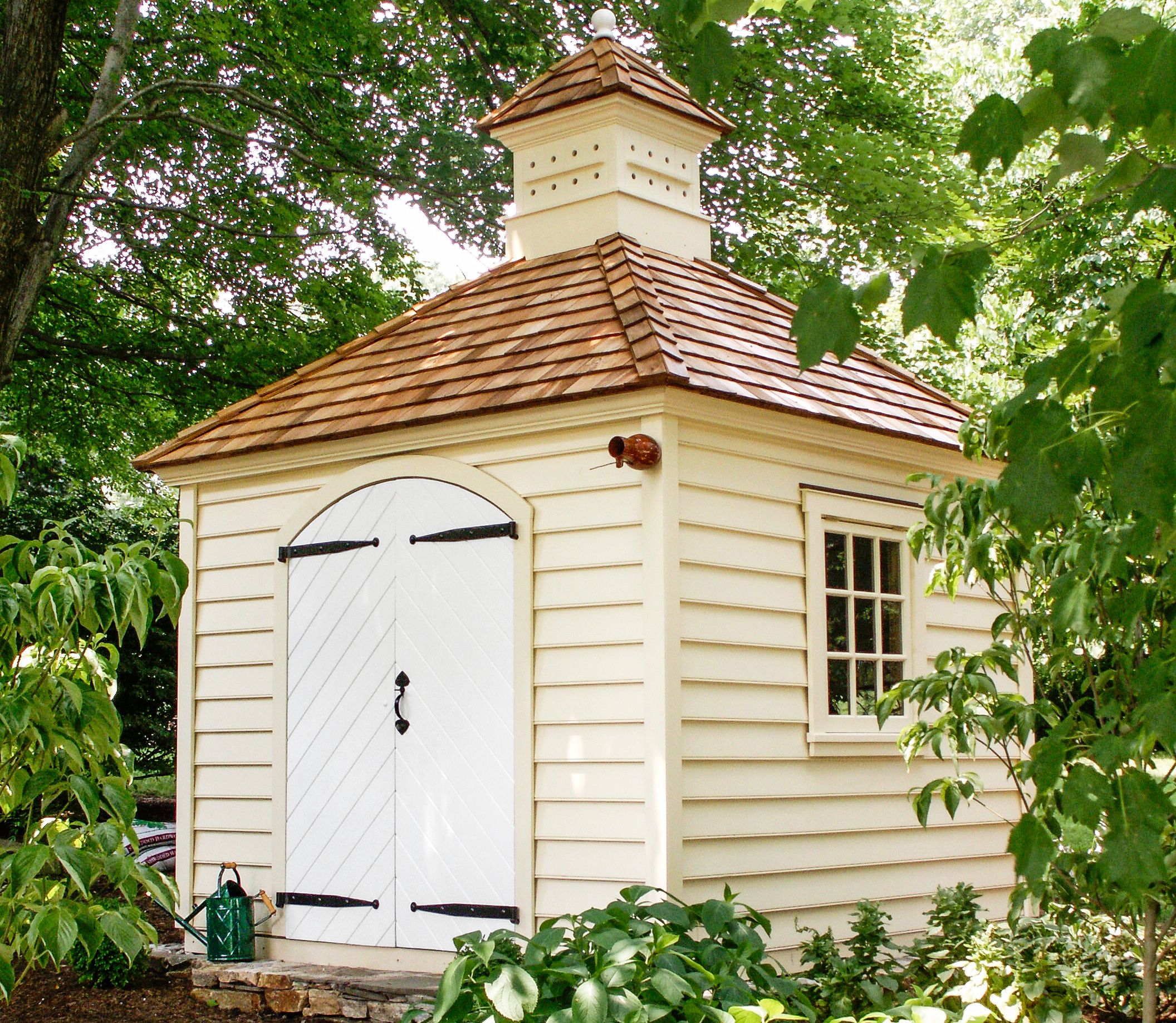
Four triangular planes, extending from the peak to each wall, form a pyramidal cap that’s stronger and more wind resistant than other roof types. Its low profile also means less room for overhead storage. A cupola, like this dovecote design, offers a stylish way to vent hot air.
Shown: 10′ x 10′ Williamsburg Classic kit, $13,150; Gardensheds, Inc.
Site Plan
Before you plunk a shed down on your property, keep these practical concerns in mind.
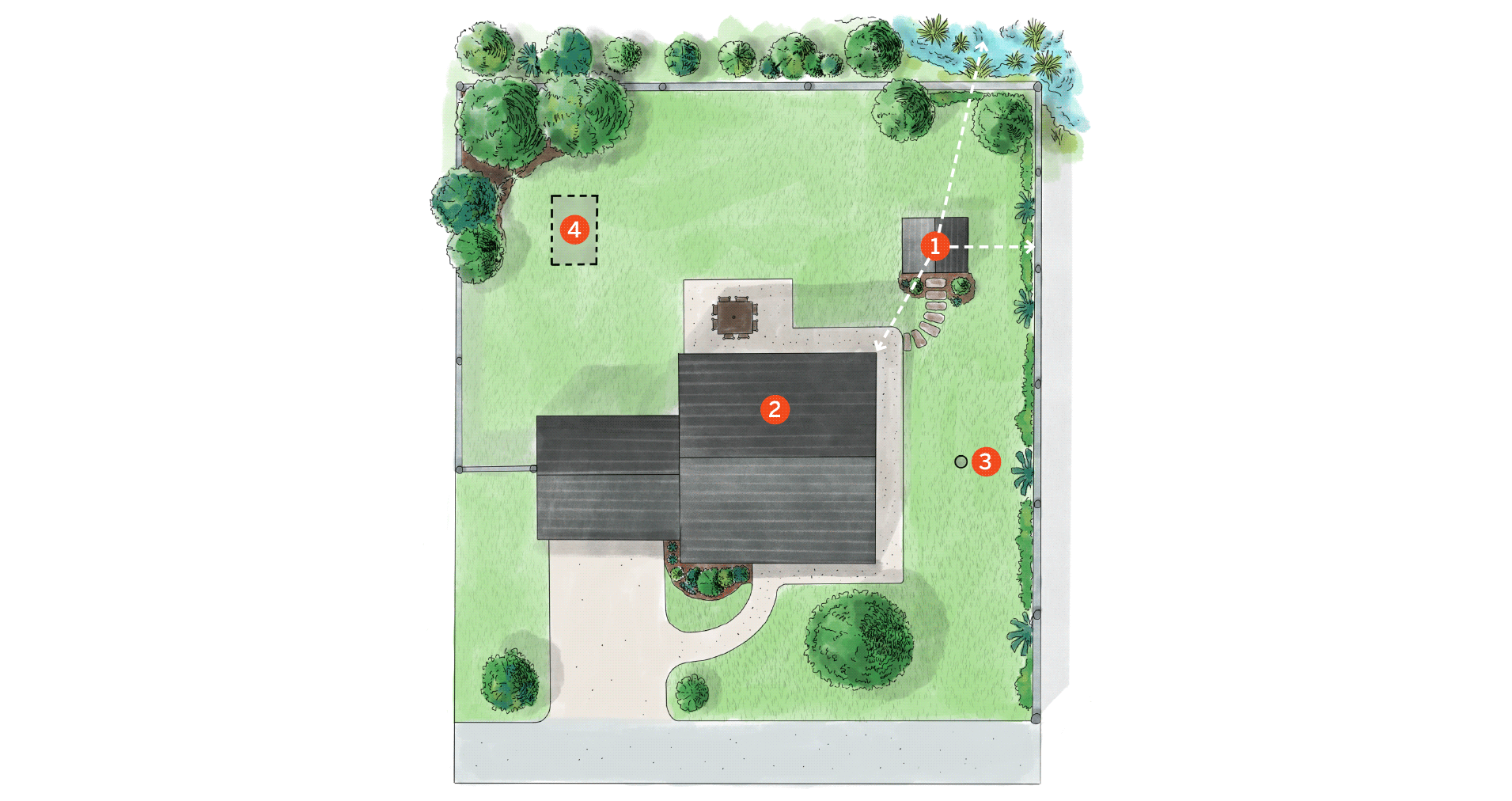
1. SETBACKS: Most towns limit how close a shed can be to property lines, your house, wetlands, and so on. Its height may be restricted too. Check with your local zoning department.
2. COVERAGE: If the shed’s footprint pushes the total square footage of all structures on your lot above a certain percent of the lot size, you may have to seek a zoning variance.
3. UTILITIES: Call 811 to ensure that no buried water, gas, or electrical lines lie in the shed’s vicinity. If you’re on a well, stay clear of its head and supply pipe.
4. SEPTIC: Make sure your shed won’t be in the way during system maintenance.
Seeing Double
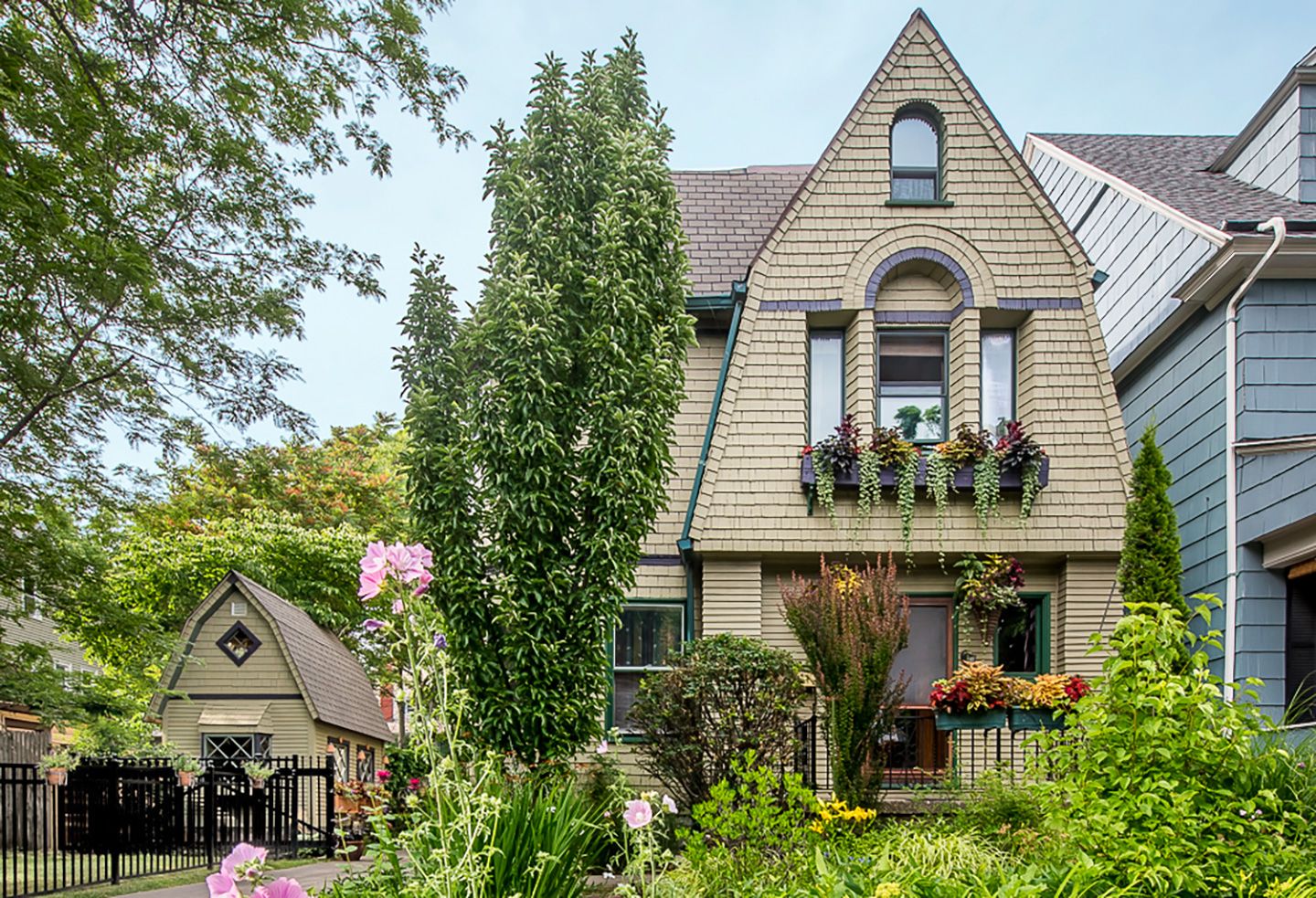
Consider placing your shed in view of passersby, who will appreciate such a thoughtful, small-scale addition to the neighborhood. The shed shown above, while not an exact copy of the house, echoes its gambrel roof and paint palette. It also incorporates materials, such as original windows, that were removed from the house when it was remodeled.
Base Support
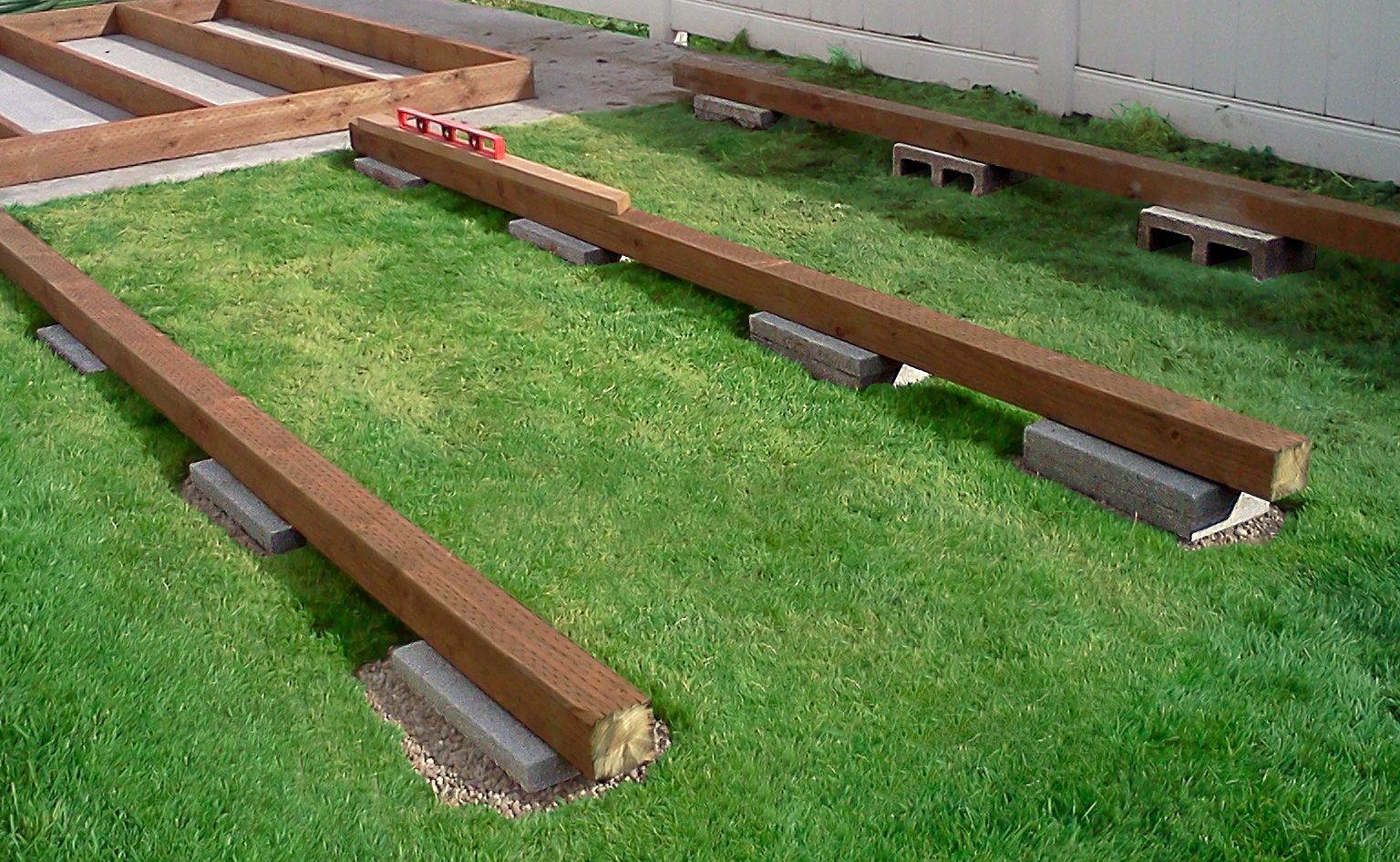
A shed needs to rest on a level, stable surface that won’t shift under its weight or in freezing weather. An on-grade wood deck or a patio can serve as the base, but most sheds are shored up by one of the following:
Crushed Stone
Well-tamped, crushed-stone pads 6 to 8 inches thick can support smaller sheds—those less than 144 square feet—and protect against frost heaves. Space the pads evenly, about 2 feet on center, then top with solid-concrete blocks to elevate the shed’s base (shown). Or build a raised bed of treated beams resting on a thick layer of crushed stone, then fill the frame with more stone.
Concrete
Larger sheds should be bolted to a reinforced-concrete slab or to concrete piers. Ground anchors aren’t needed, but in cold climates, slabs must be frost-protected, and piers must rest on wide footings dug below the frost line.
Arrowhead-Style

An arrowhead-style anchor, driven into firm soil with a rod and sledgehammer, can resist more than a ton of tension. Pull its cable taut to set the metal anchor, then bolt the cable’s eye to the shed’s framing.
A shed sitting on crushed stone can shift or topple in high winds or floods. To prevent that, sink a ground anchor, like those from American Earth Anchors, at each corner and bolt them to the shed’s base.
Garden Shed Doors
Sliding or Swinging
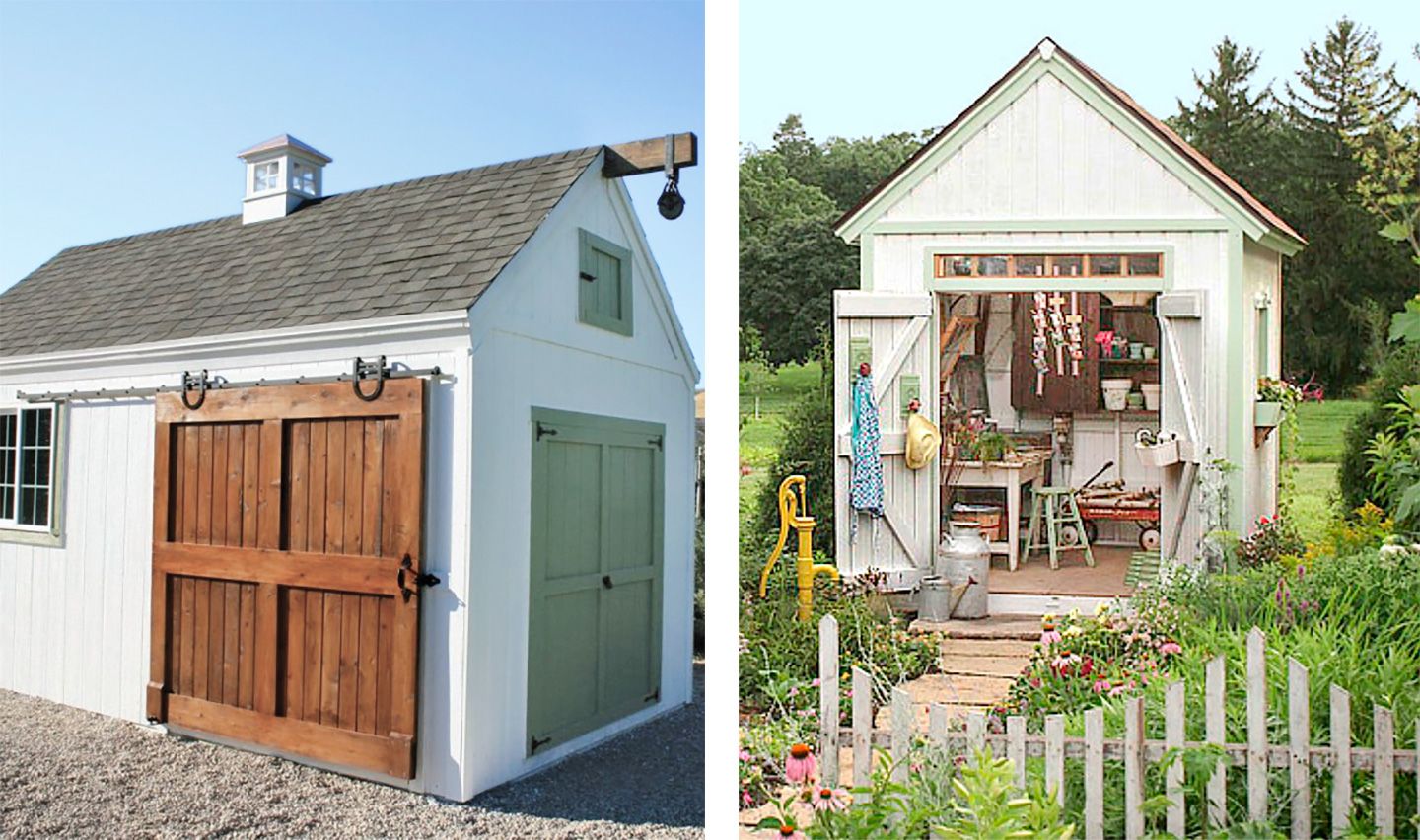
Whether single or double, sliding doors (shown left) cover a wide opening, while rolling to the side with ease. Hinge-hung swinging doors (shown right) are lighter, fit tighter, and don’t need as much wall space, but you’ll have to shovel when snow builds up in front of them. While most lawn equipment can fit through a 3-foot-wide doorway, allow 4 to 6 feet for a lawn tractor.
Sliding door: Custom 1216 Orchard Shed, Wright’s Shed Co.
Swinging doors: 1010 Telluride workshop, Summerwood Products
Entry Steps or Ramps
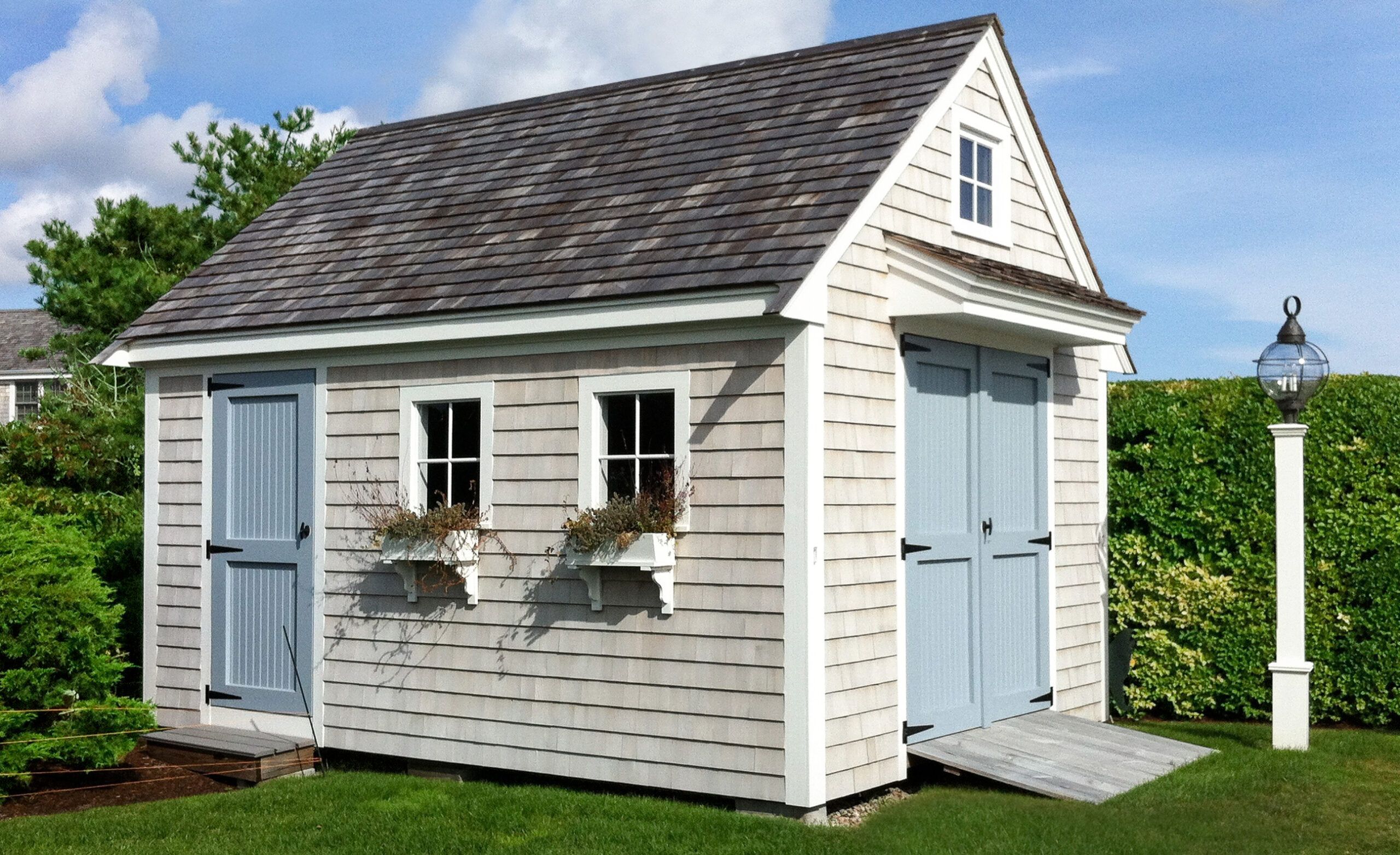
Like houses, sheds have elevated doorways, requiring either entry steps or ramps. A ramp (shown) is a must for wheeling heavy equipment in and out. A separate entry door with steps allows you to segregate bulky equipment at the ramp end.
Ramp: 1216 Cape Codder, Pine Harbor
Garden Shed Decorating Ideas: Plants
Rustic Simplicity
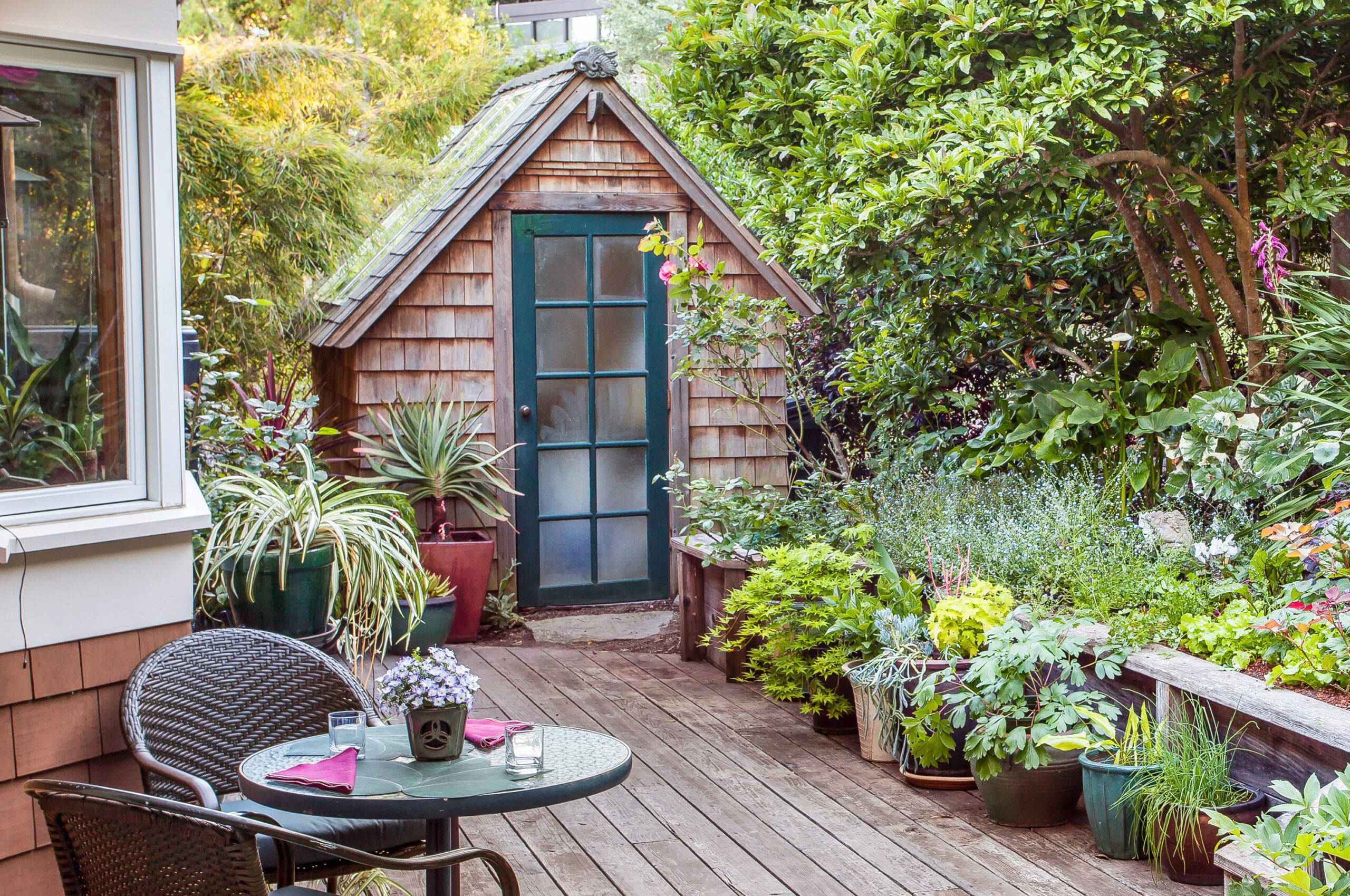
Increase a shed’s appeal by integrating it into the landscape.
Sited between a stand of bamboo and a magnolia, this shed’s weathered shingles help it blend into its deckside location. Potted plants soften the transition and nestle the building into its verdant backdrop.
Cottage Look
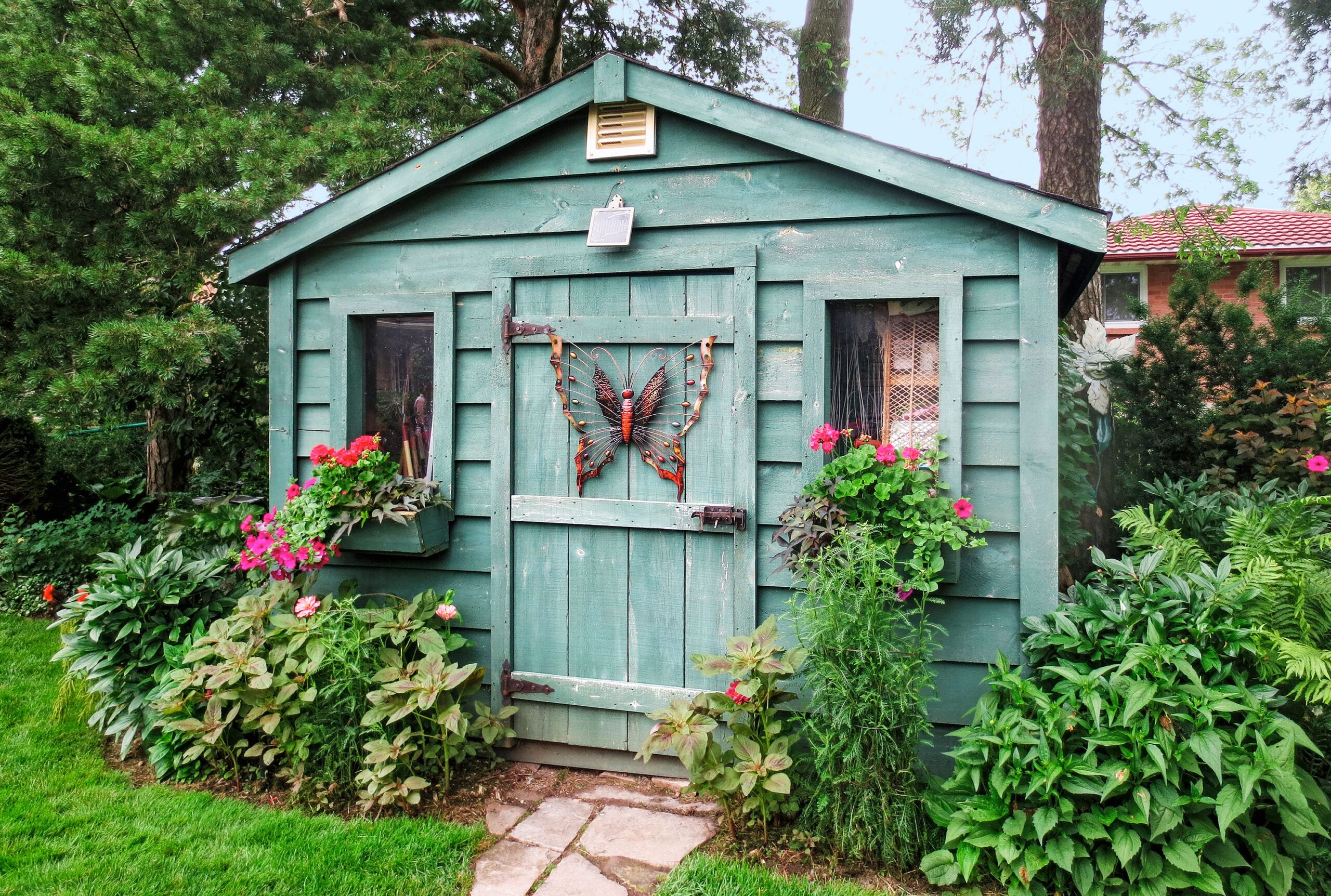
Window boxes filled with pelargonium and petunias spill into shrub-based foundation plantings, connecting this clapboard structure—painted a garden-friendly blue-green—to the beds that surround it.
Semiformal
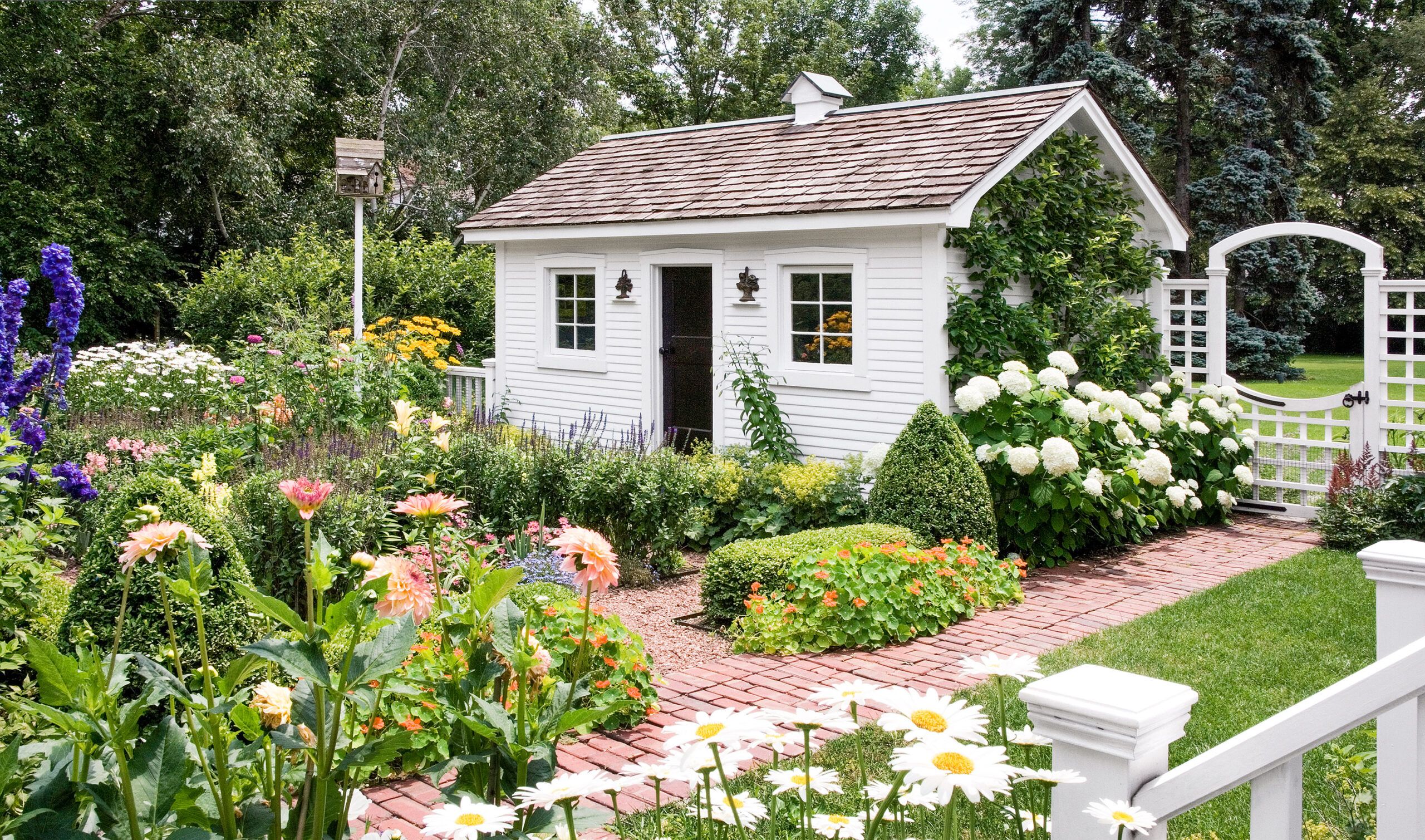
With fencing anchored to it at either end, a crisp-white shed becomes part of the framework for this manicured garden. Lady’s mantle, boxwood, and hydrangea grow tidily up close, with more riotous blooms farther out. An apple-tree espalier covers one of the shed’s gable ends, which provides the backbone for the tree’s supports.
Semiformal: Landscape design by Craig Bergmann, Craig Bergmann Landscape Design, Lake Forest, IL
Garden Shed Storage Ideas
Repurposed Rack
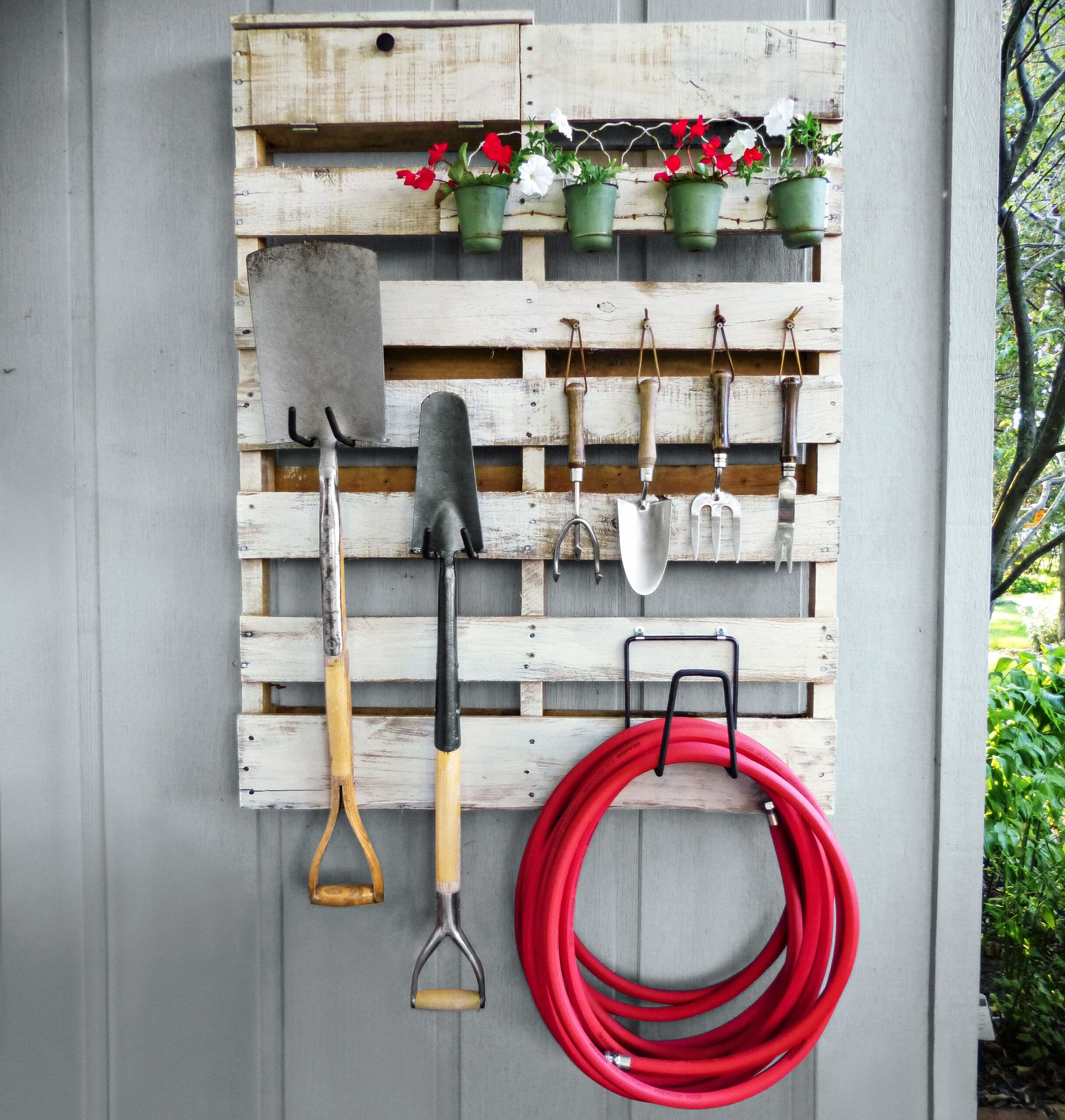
A shed’s floor space is quickly claimed by large equipment and a workbench. So look up—walls, rafters, even ceilings offer opportunities for accessible, organized storage.
A discarded pallet hung on an interior—or exterior—wall can provide a convenient and inexpensive surface for hanging essential gardening tools and accessories.
Organize: Hooks, Metal Tubs, Bins & Baskets
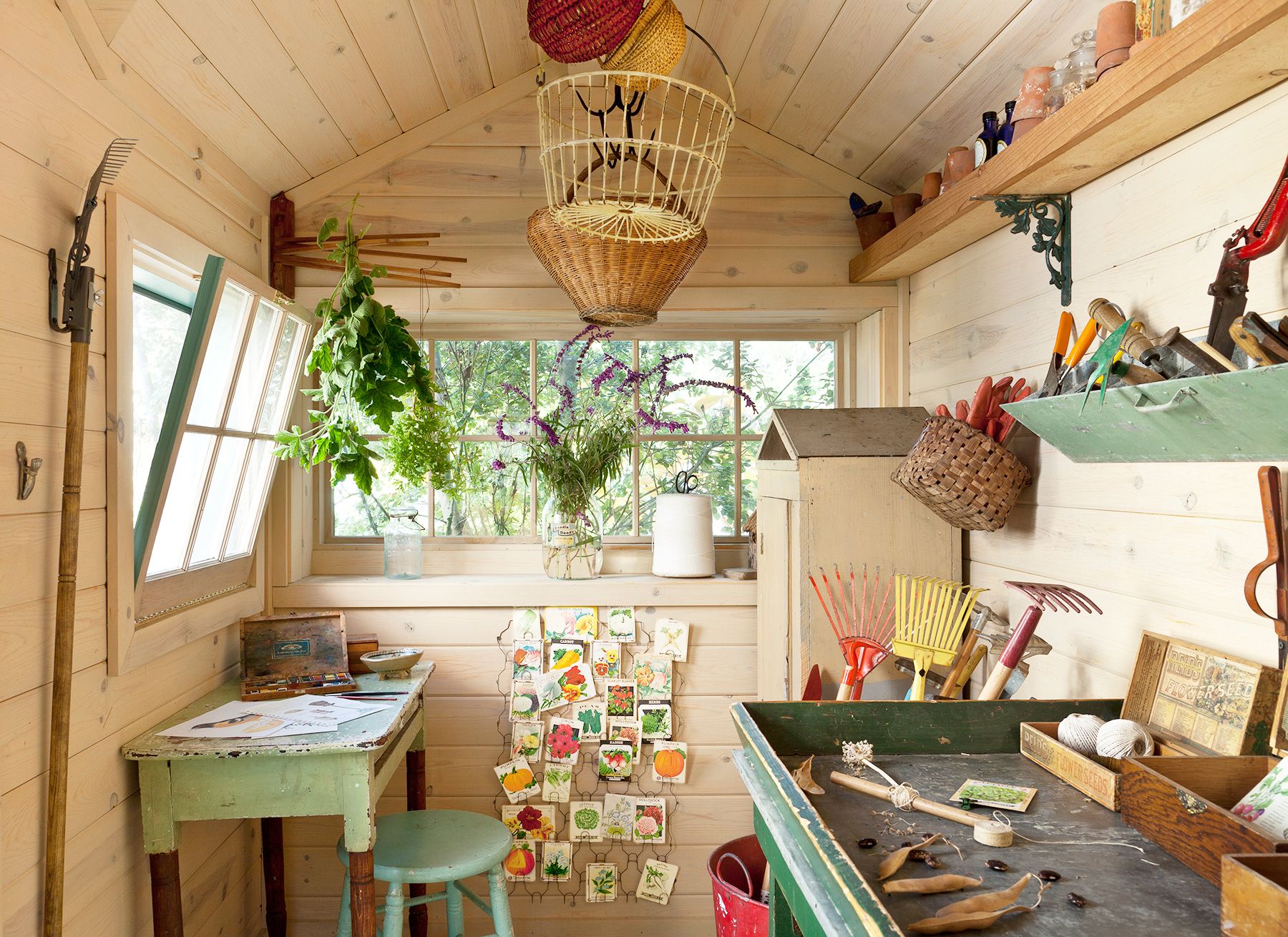
Long-handled tools can hang from hooks or stand up in metal tubs, while short-handled ones cluster in wall-hung bins or baskets. Here, a wire rack corrals colorful seed packets, and the swing arms of a dish-towel rack hold bundles of drying herbs. High on the wall, shelves keep fragile pots safe; extra baskets swing from hooks screwed to the ridge beam.
S-Hooks and Pegboards
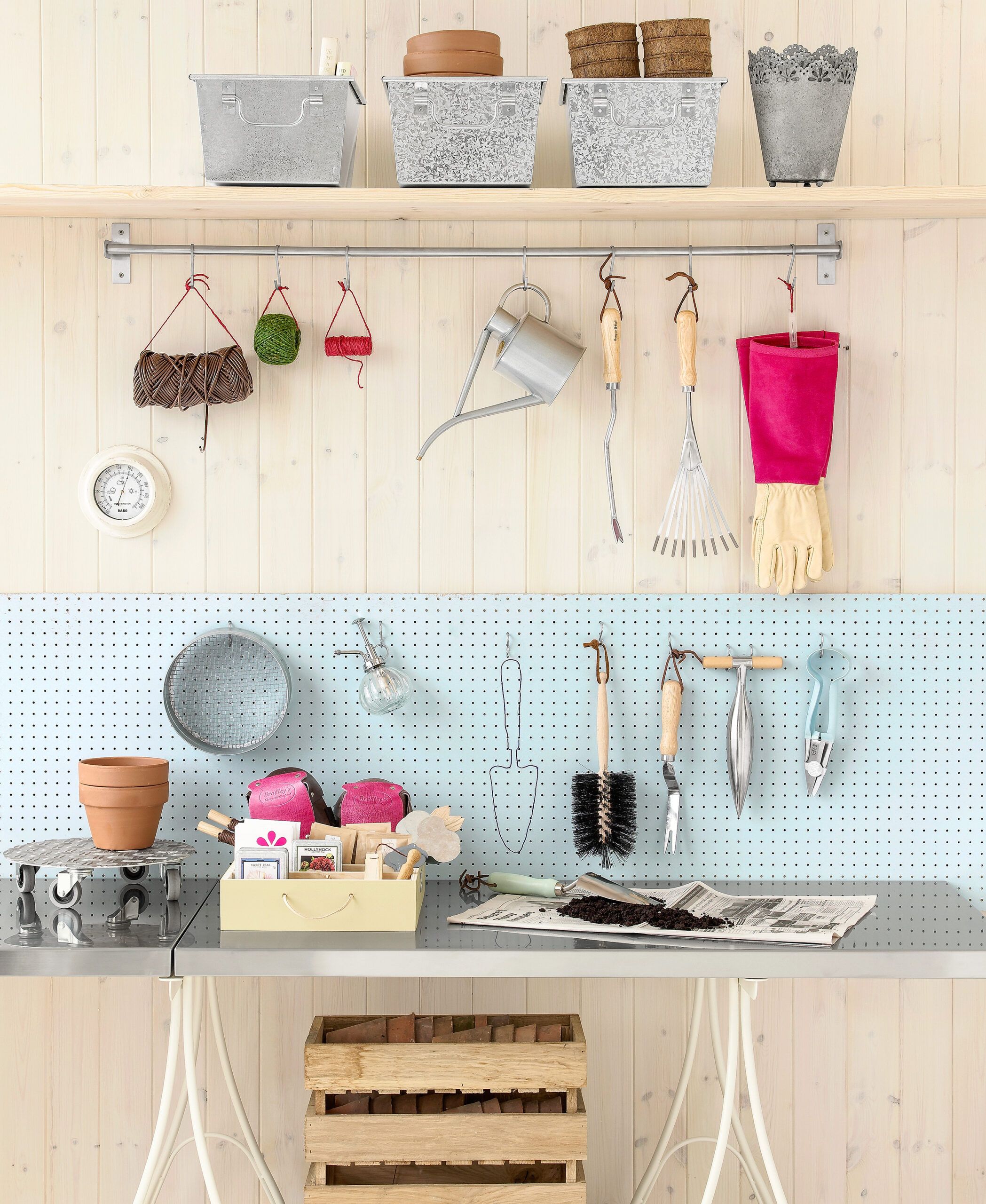
A rod made for kitchen utensils holds gear on repositionable S-hooks. Outlines on pegboard identify what hand tools go where.
Installing Utilities
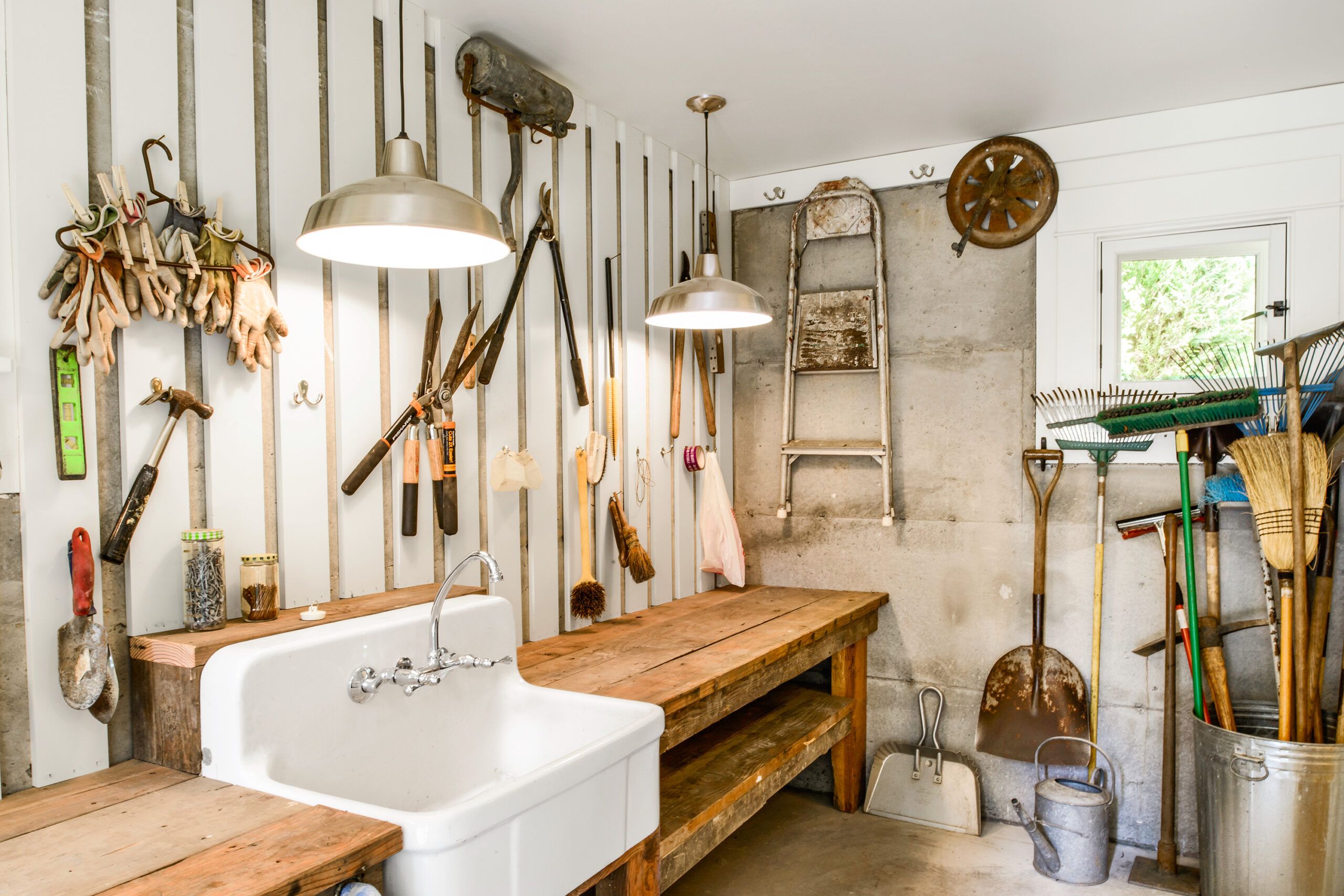
Supplying your shed with water and electricity multiplies the ways you can make use of it—and the amount of time you’ll spend there. Hire licensed pros to do the work and obtain the necessary permits.
Electricity
Lights allow you to use your shed into the evening and make it easier to find and put away your tools. Outlets provide juice for power tools and recharging batteries. For safety’s sake, every outlet has to be GFCI protected, and the electrical cable coming from the house must run through a PVC conduit buried at least 18 inches deep.
Heating / Cooling
Once a shed has electricity, adding heat or air-conditioning is not a big step. A small ductless heat-pump system with an indoor unit mounted on one wall will keep the interior warm in cold months and cool in the hot ones.
Water
With a sink in your shed, you can give potted plants a drink and clean dirty hands and tools; no wrestling with a hose or running back and forth to the house. A supply pipe set in a shallow trench—at least 18 inches deep—should have a compressed-air fitting so you can blow out the water before winter arrives. But in a heated shed where water is used all winter, that pipe must be buried well below the frost line. Run the sink’s drain to a dry well. For hot water, get a small electric water heater, like the kind used in RVs.
Custom carpentry: Paul Johnson, Portland, OR
Custom Accent Ideas
There’s no limit to the inventive ways of shed owners and designers.
Hip Roof
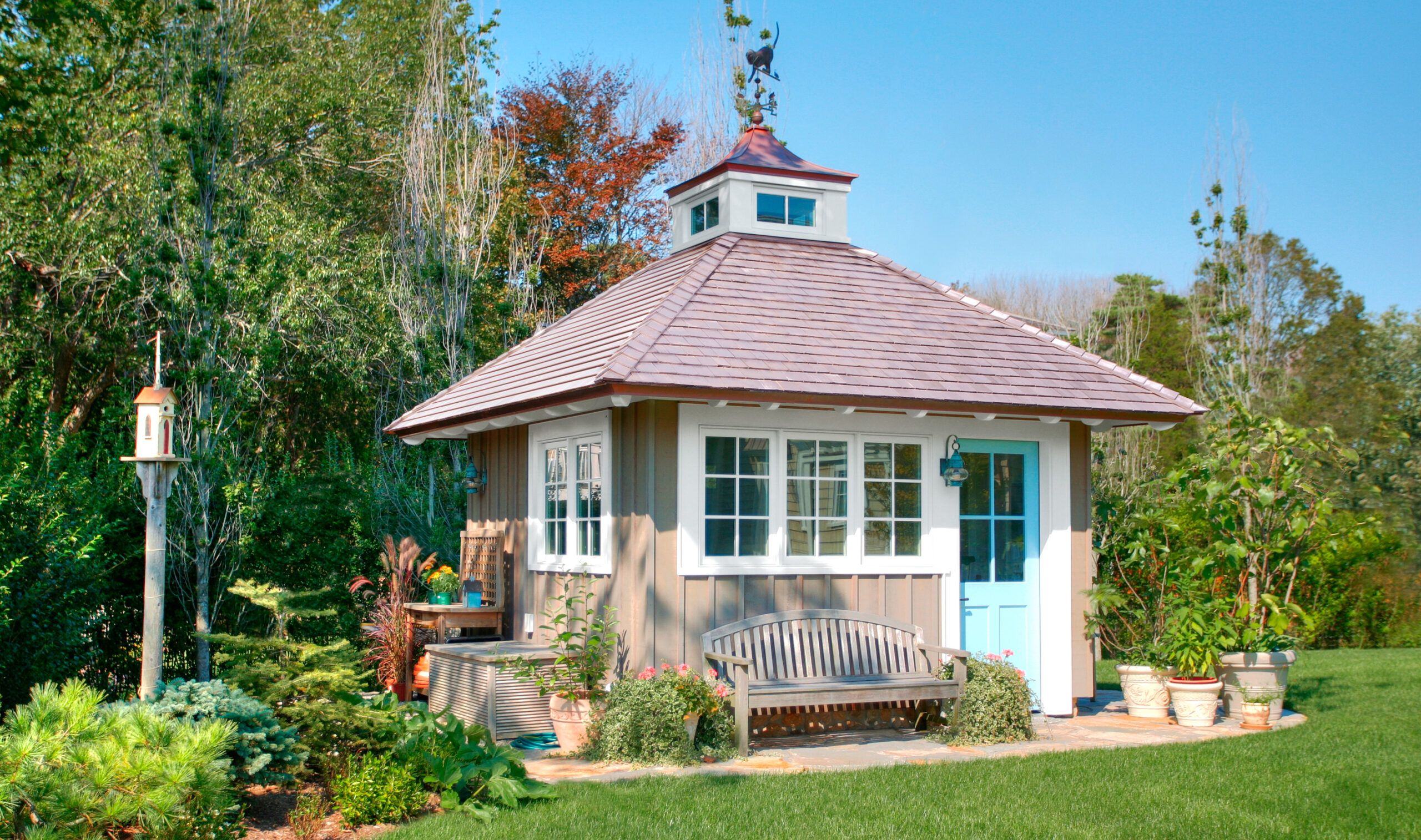
The gutters on this hip-roofed, 10-by-10-foot shed feed rain into a cistern under its slab that’s used for supplemental watering. Awning windows in the cupola bring light to the interior and can be opened via remote to ventilate it. Wide eaves shelter a bench seat and potting table.
Design: Campaigne Kestner Architects, Guilford, CT
Green Roof

Tousled sedums keep this shed’s interior cool and minimize runoff. A roof of this sort has to be structurally reinforced to handle the weight of soil and plants, and then covered with layers of waterproofing membrane to keep the wood structure dry before planting.
Colorful Paint Job
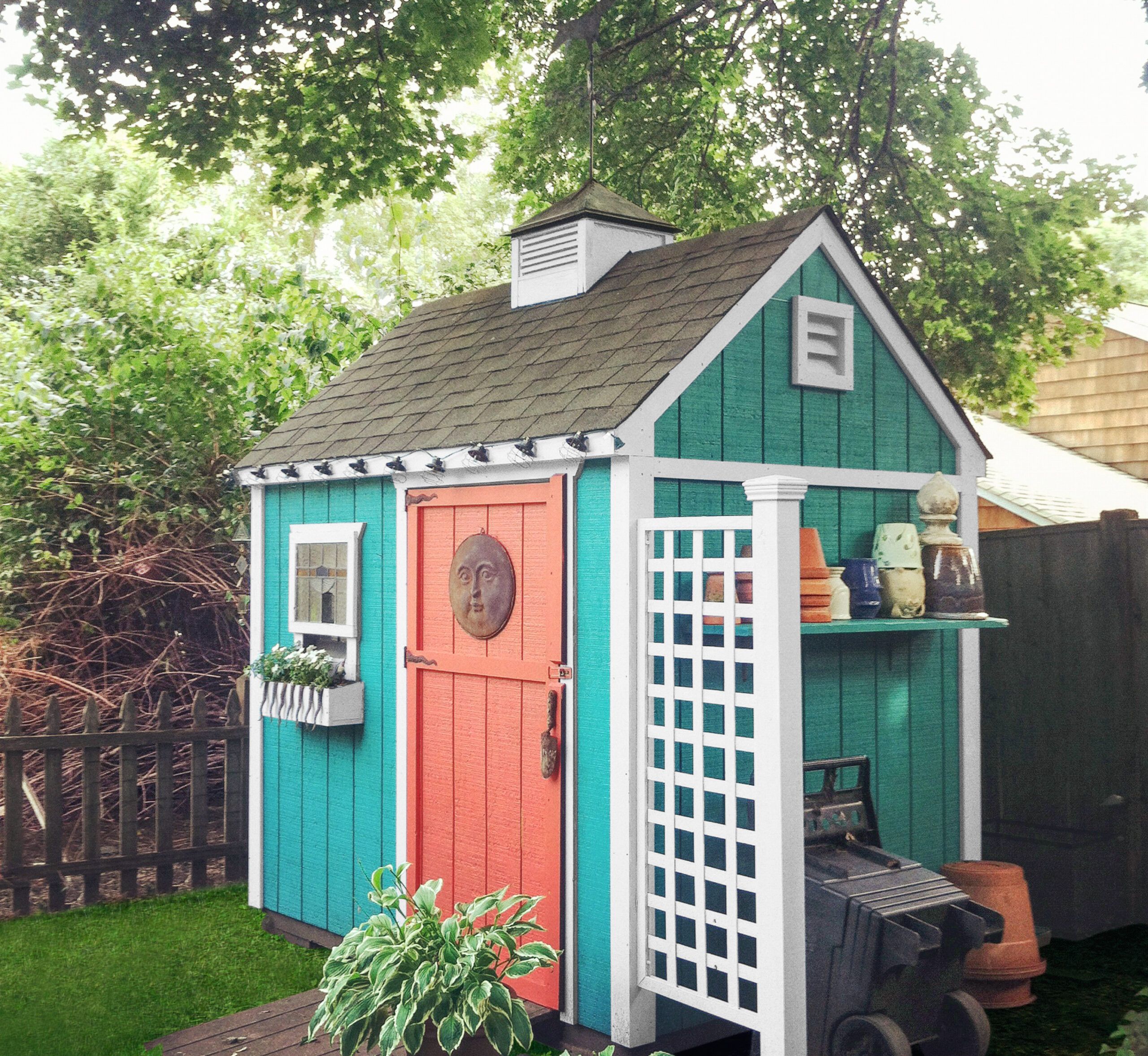
Bold hues brighten this plywood-sided shed and the shady backyard corner where it’s located. Clever add-ons include an outdoor shelf for pots and a lattice-fence panel that hides it as well as the wheelbarrow stored below. An old trowel serves as the door handle.
Design: DIY makeover by Debbie Gonville Miller
Recycled and Reused
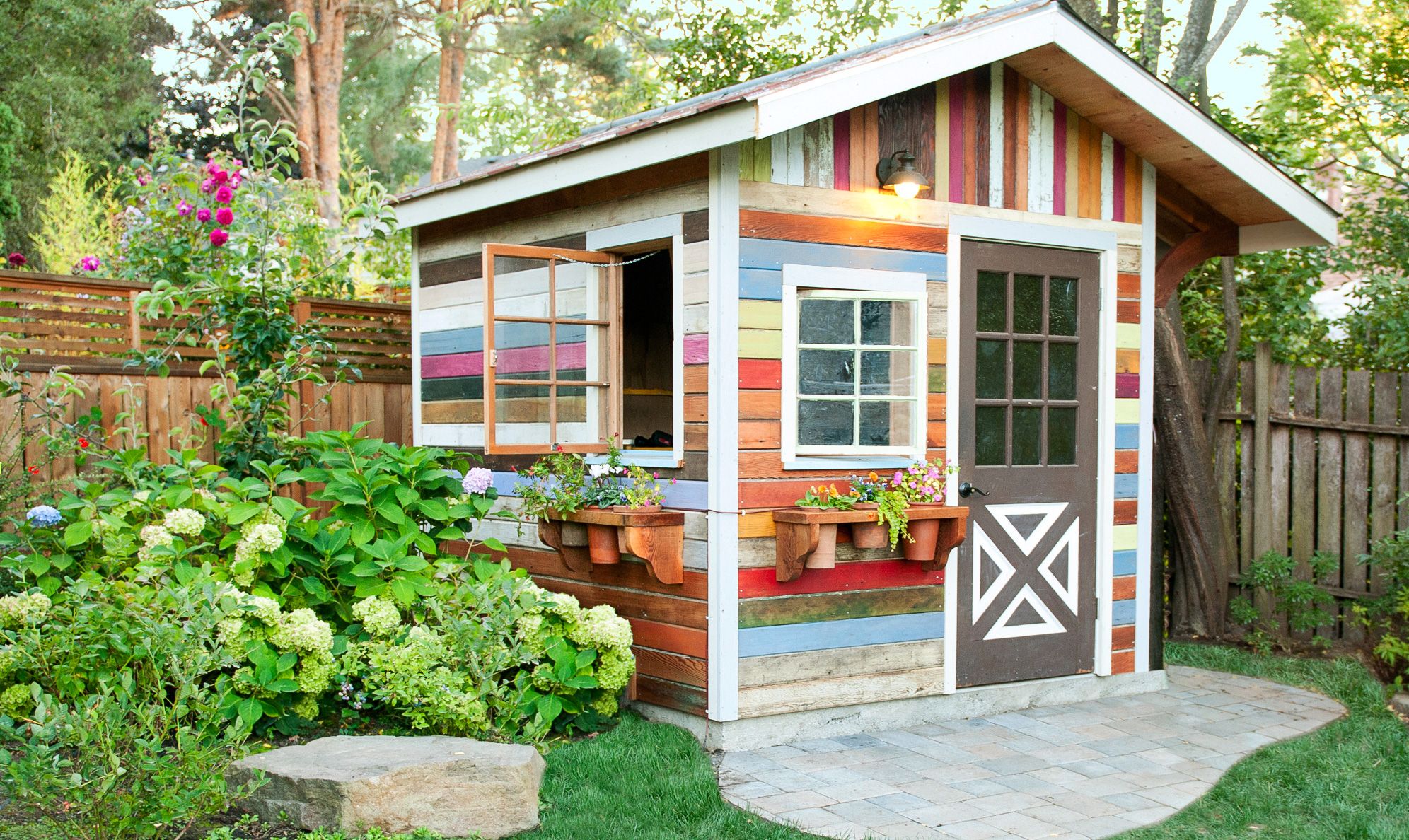
The wood siding and metal roof on this scratch-built shed once covered an old barn, and the windows and door were found at a Habitat for Humanity Restore. Leftover paint collected from around the neighborhood created the random color scheme.
Design: DIY project by Amber Lee
Greenhouse Hybrid
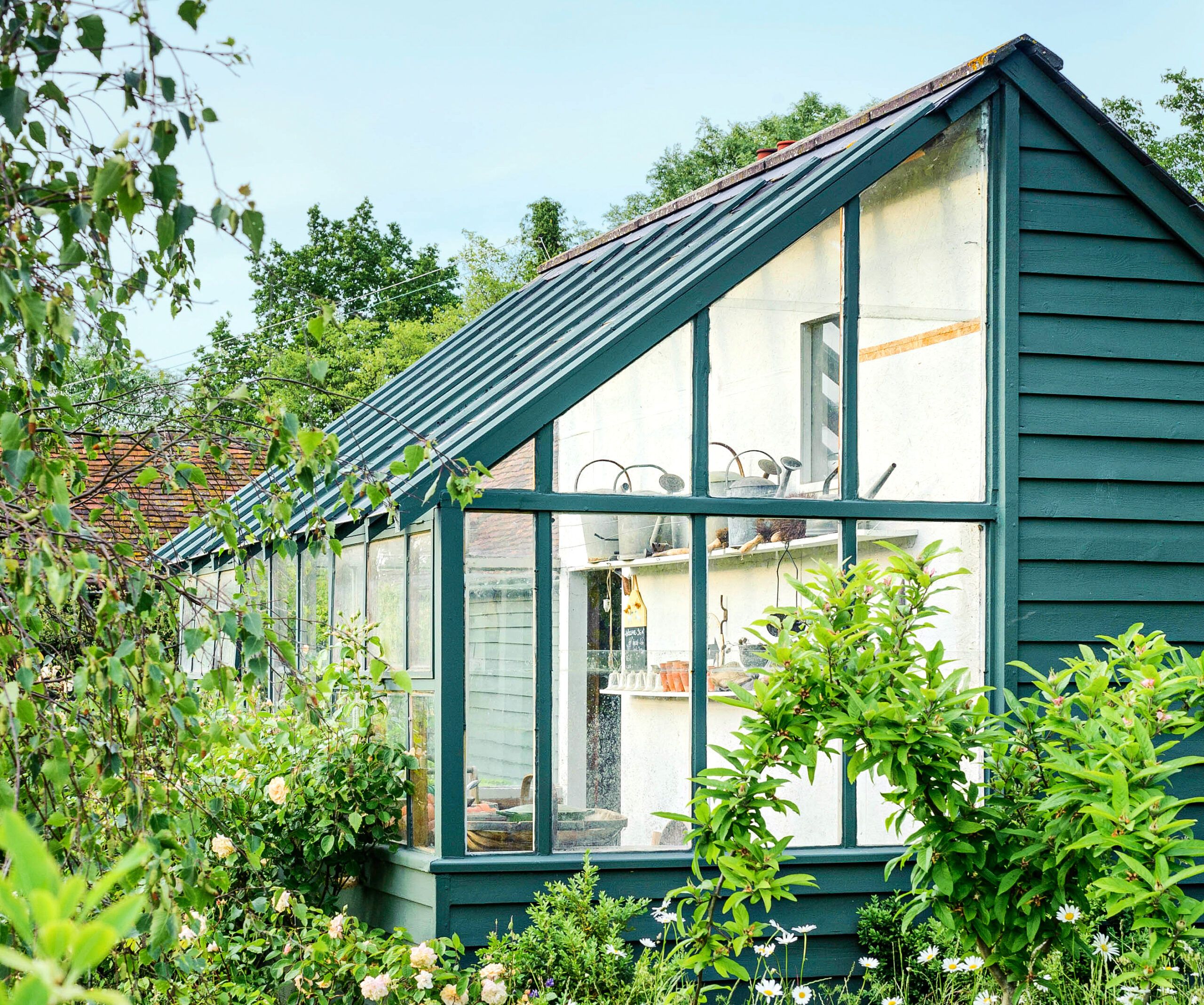
Marrying a greenhouse with a shed allows you to extend the gardening season into winter. In sunny climates, position the glass roof toward the east or north to avoid extreme heat buildup, and provide plenty of ventilation to prevent your plants from being cooked.
Fairy-Tale Charm
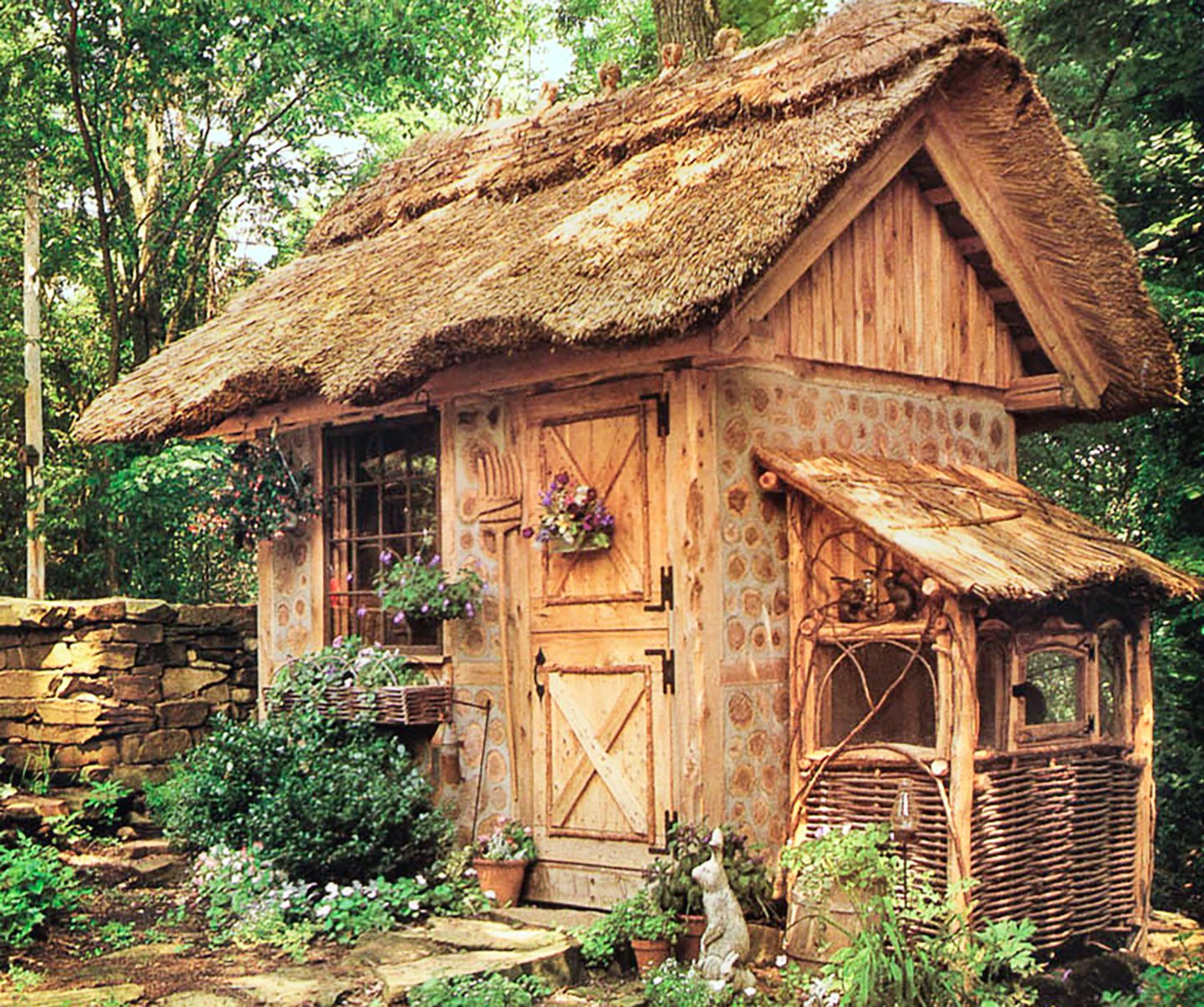
This 9-by-12-foot potting shed, meant to evoke traditional outbuildings in the Irish countryside, has a Dutch door, cordwood walls—log rounds embedded in mortar—and a thick thatched roof. The thatched lean-to, woven from willow switches, serves as a rabbit hutch.
Thanks to: Ken Smith, Gardensheds. Jamie McGrath, Pine Harbor Wood Products. William P. Cahill.
